historical blogs (Sept. 2009 to Jan. 2017)
December 2016: Back to San Francisco for my last visit until 2020 (when they reopen the Moscone center for conferences). AGU was hectic as usual and I gave an interesting talk that really puts some of my ideas into a wider, climatic context. Here's my title slide: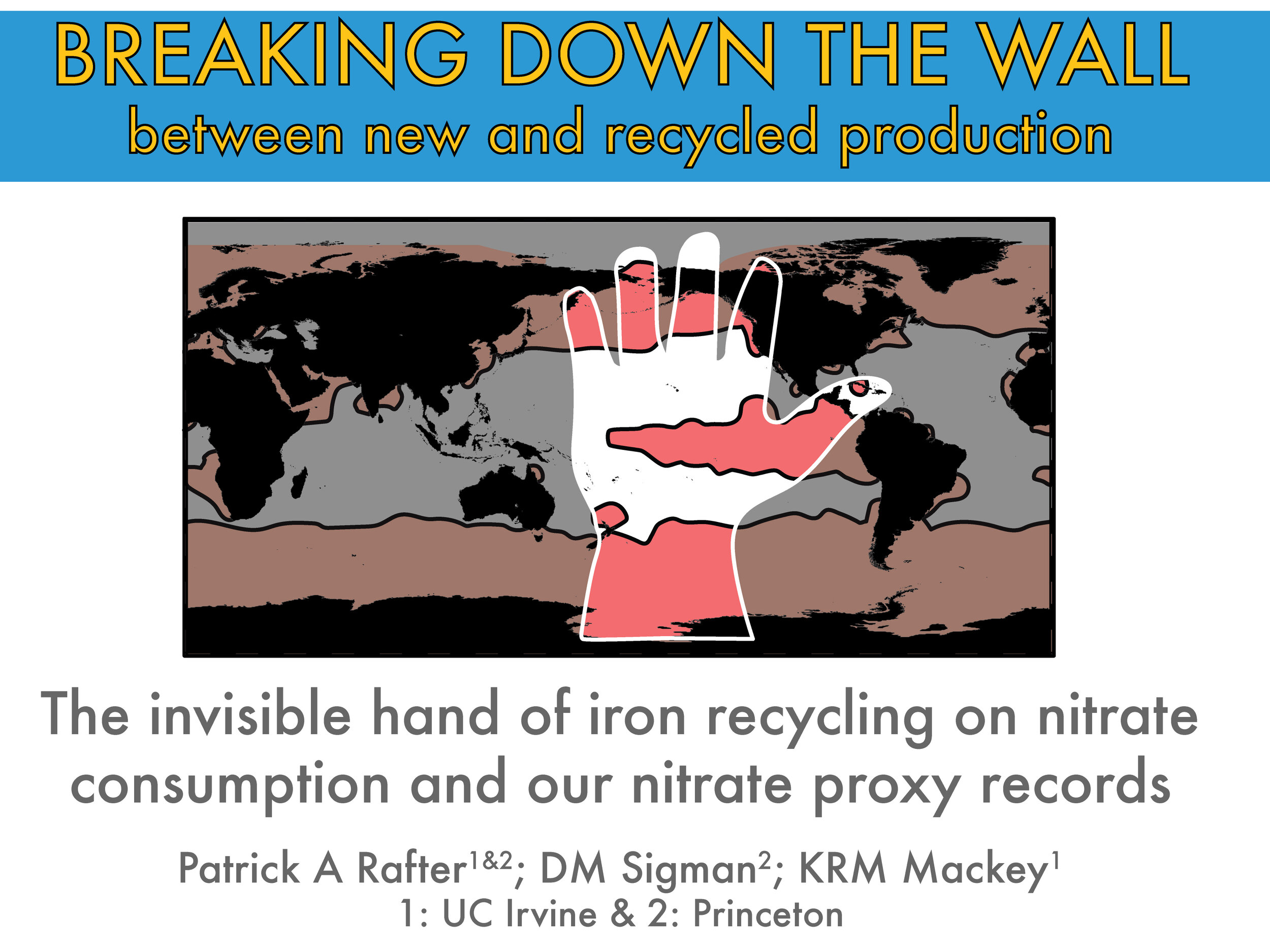 Mixed metaphors aplenty. The final sentence of the talk:The invisible hand of iron recycling: "The term 'invisible hand' is a metaphor for how, in a free market economy, self-interested individuals operate through a system of mutual interdependence to promote the general benefit of society at large -investopedia.comNovember 2016: I have two new studies examining the oceanography of the Gulf of California—one using coral (covering the past 60 years at bi-monthly resolution) and another using ocean sediments (covering the past 30,000 years). We know what year it is as we go back in time with the coral because they have annual growth bands (just like a tree). On the other hand, finding out what year it is in the ocean sediment (mud) is much more difficult. Fortunately for me, we are finding microscopic pieces of trees and shrubs in the mud! We like this because we can measure the rare, radioactive isotope of carbon (14C) and get a sense for what year it is for that part of the mud. To paraphrase one of my mentors, it's like finding pieces of gold (actually worth more than gold if you ask me).This is a long way of saying, here are some very cool photos of twigs I've found in Gulf of California sediment:
Mixed metaphors aplenty. The final sentence of the talk:The invisible hand of iron recycling: "The term 'invisible hand' is a metaphor for how, in a free market economy, self-interested individuals operate through a system of mutual interdependence to promote the general benefit of society at large -investopedia.comNovember 2016: I have two new studies examining the oceanography of the Gulf of California—one using coral (covering the past 60 years at bi-monthly resolution) and another using ocean sediments (covering the past 30,000 years). We know what year it is as we go back in time with the coral because they have annual growth bands (just like a tree). On the other hand, finding out what year it is in the ocean sediment (mud) is much more difficult. Fortunately for me, we are finding microscopic pieces of trees and shrubs in the mud! We like this because we can measure the rare, radioactive isotope of carbon (14C) and get a sense for what year it is for that part of the mud. To paraphrase one of my mentors, it's like finding pieces of gold (actually worth more than gold if you ask me).This is a long way of saying, here are some very cool photos of twigs I've found in Gulf of California sediment: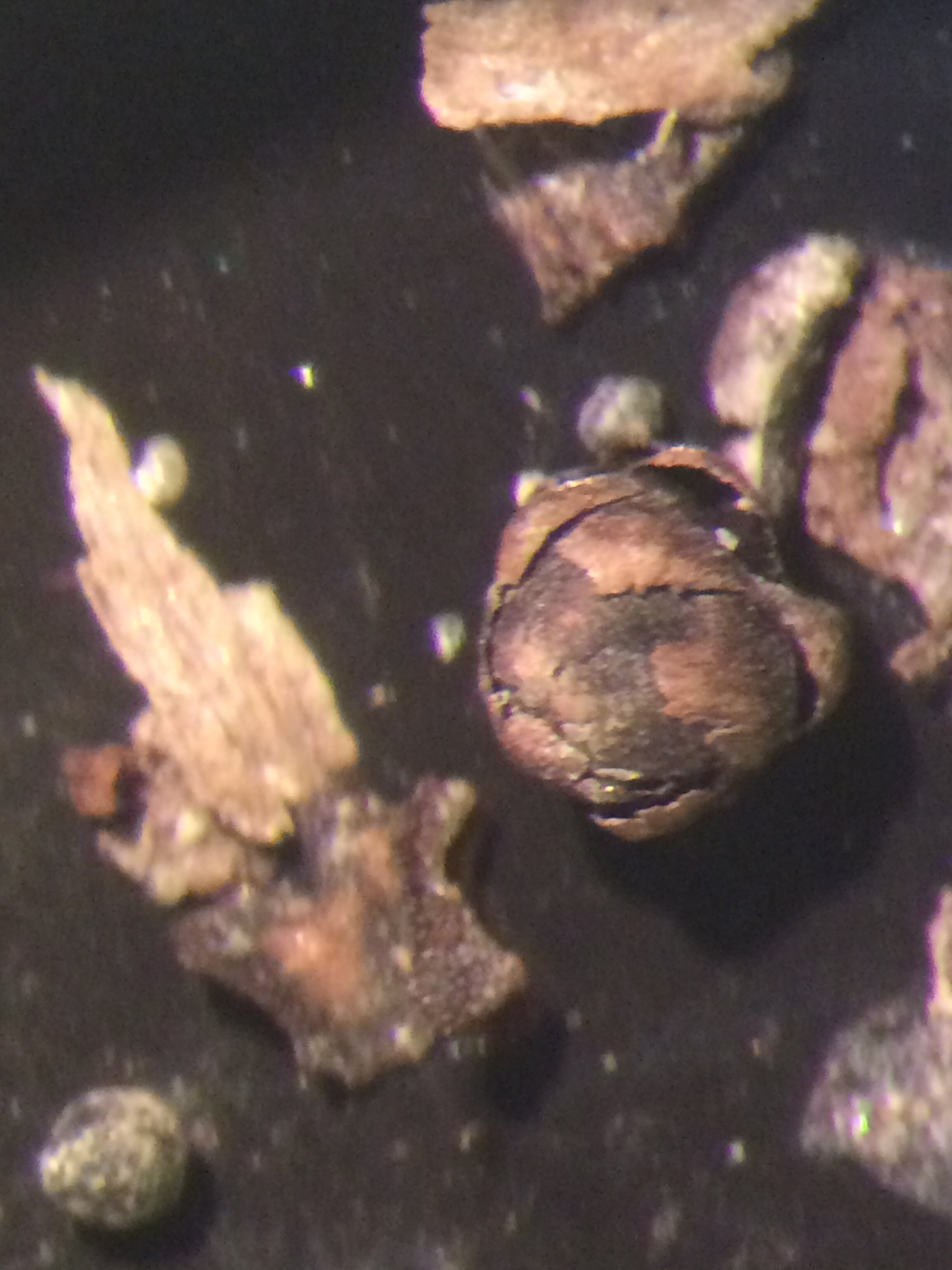
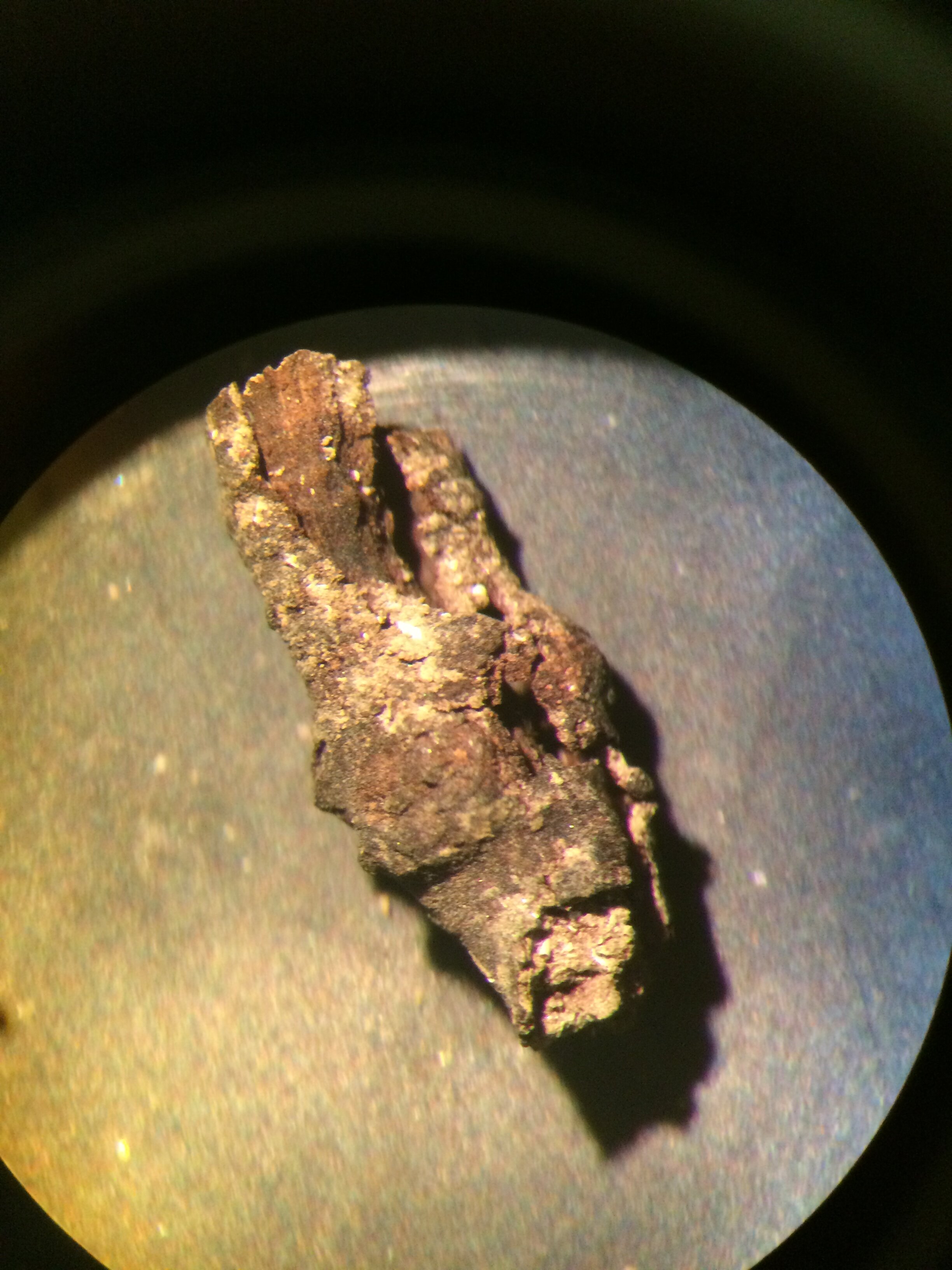 October 2016: My first trip to UC Riverside for a requested talk on "Pliocene Permanent El Nino". Great group.I took no photos though...September 2016: International Conference on Paleoceanography in Utrecht, Netherlands. I rented a bike and joined the community commute into the city every morning with good friend and colleague Francois Fripiat. It was an amazing experience!
October 2016: My first trip to UC Riverside for a requested talk on "Pliocene Permanent El Nino". Great group.I took no photos though...September 2016: International Conference on Paleoceanography in Utrecht, Netherlands. I rented a bike and joined the community commute into the city every morning with good friend and colleague Francois Fripiat. It was an amazing experience!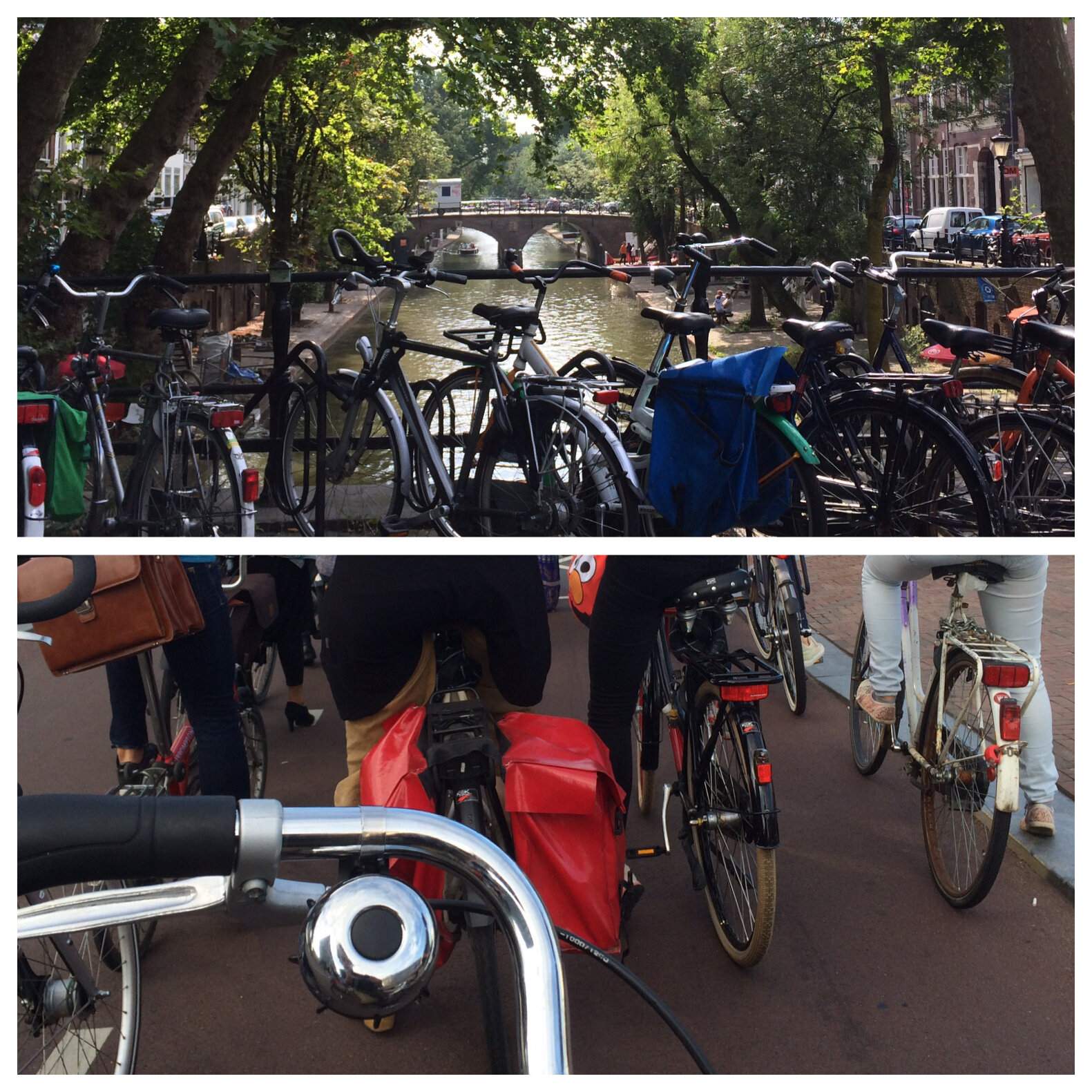
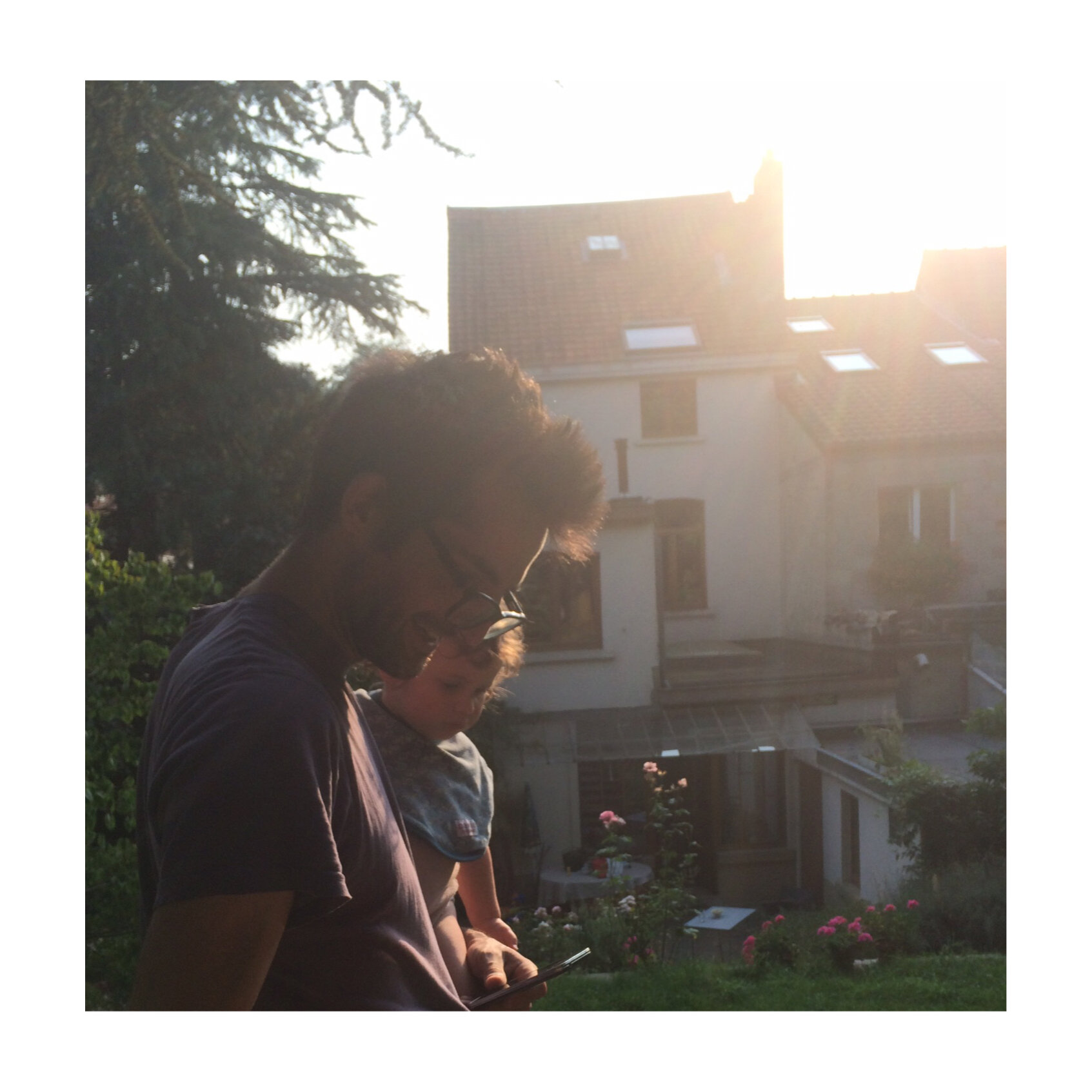 (Francois with Salome)July 2016: This week is the Radiocarbon Short Course at UC Irvine. We are all helping out wherever we can.
(Francois with Salome)July 2016: This week is the Radiocarbon Short Course at UC Irvine. We are all helping out wherever we can.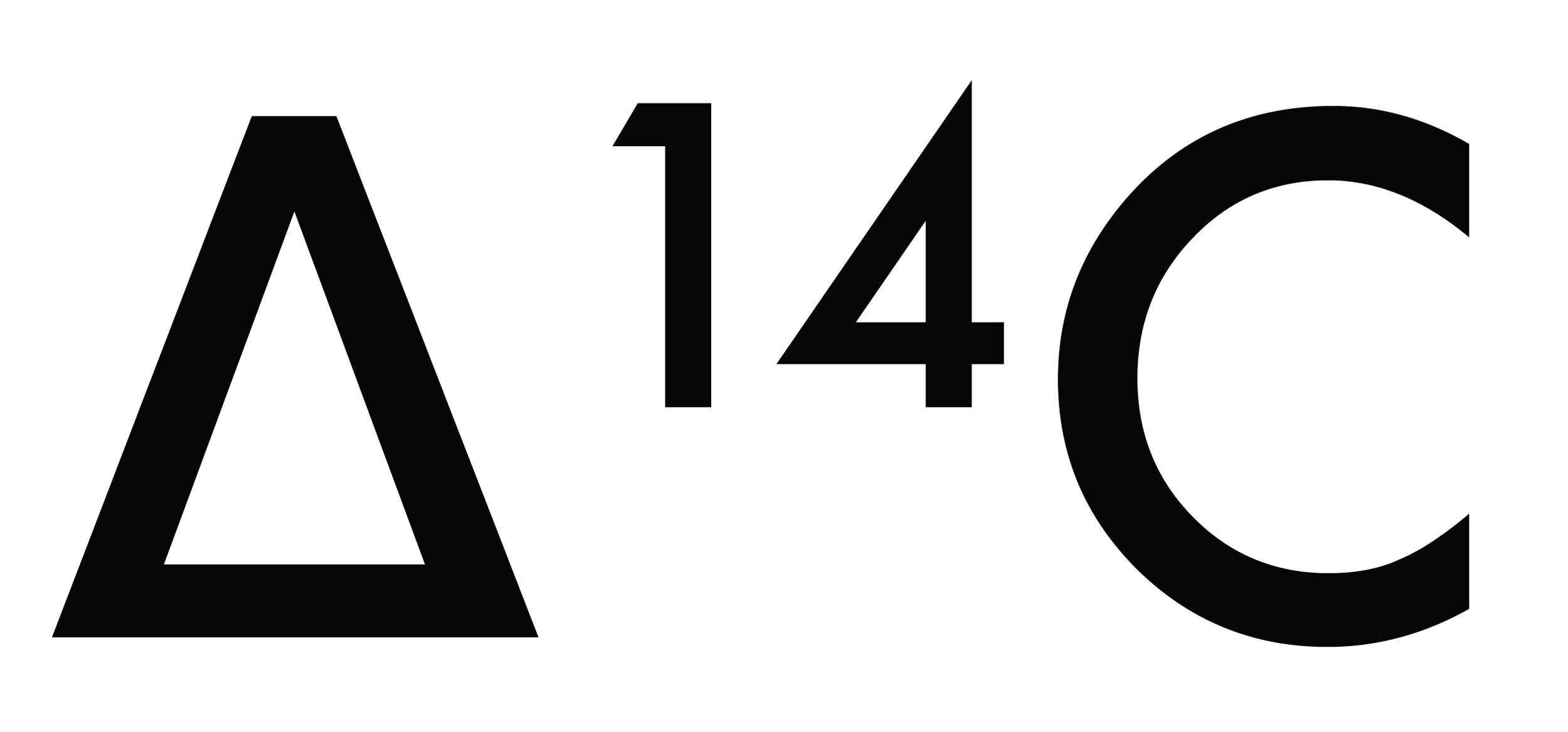 April 2016: Back to Cal Tech, this time to give a talk on internal nutrient cycling in iron-limited ocean regions.
April 2016: Back to Cal Tech, this time to give a talk on internal nutrient cycling in iron-limited ocean regions.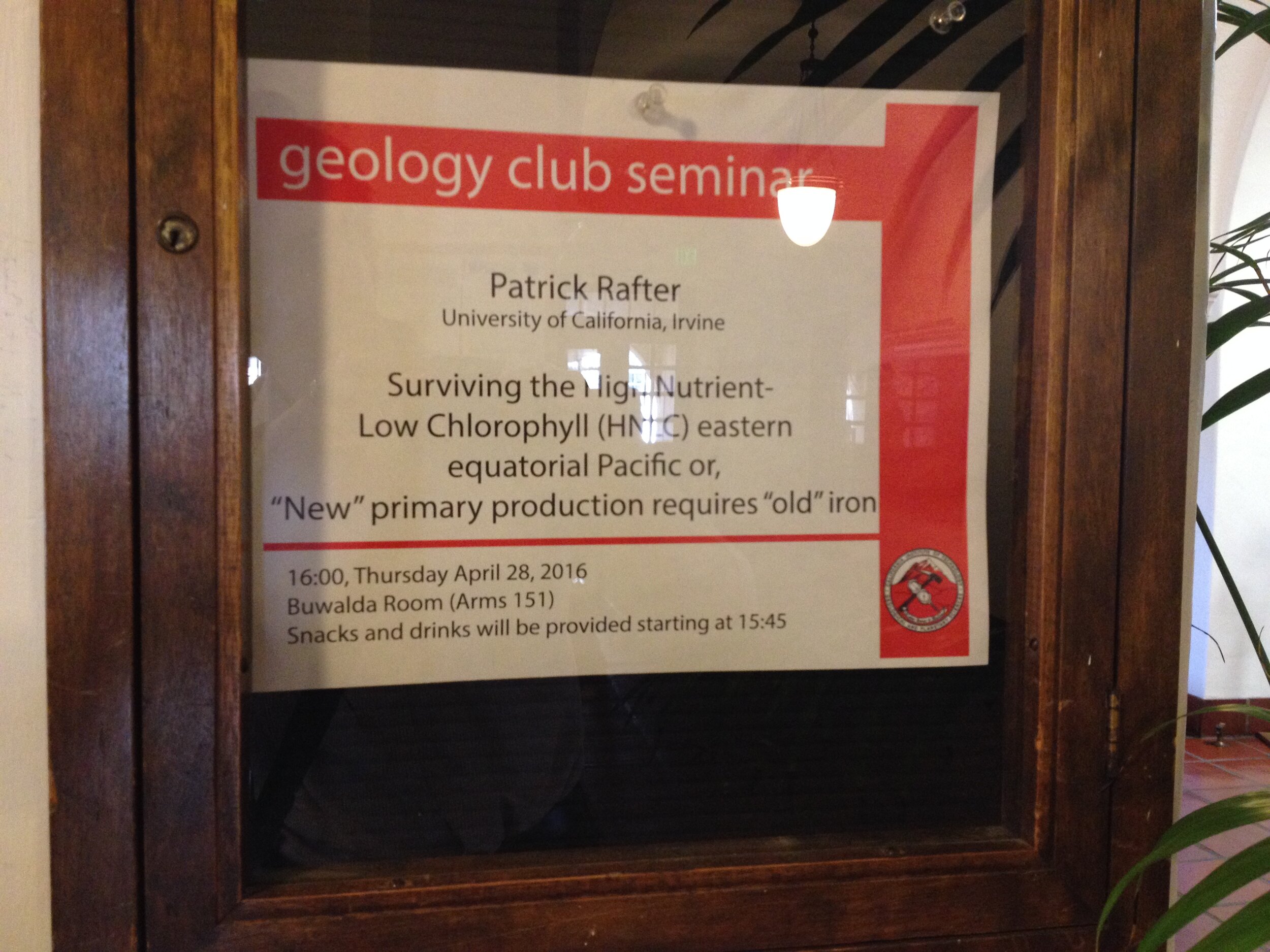 February 2016: (Ocean Sciences: New Orleans week) Ten years ago this week I had my first public discussion of my science at the 2016 Ocean Sciences meeting. I got some things wrong in this early work, but this design is pretty tight!
February 2016: (Ocean Sciences: New Orleans week) Ten years ago this week I had my first public discussion of my science at the 2016 Ocean Sciences meeting. I got some things wrong in this early work, but this design is pretty tight!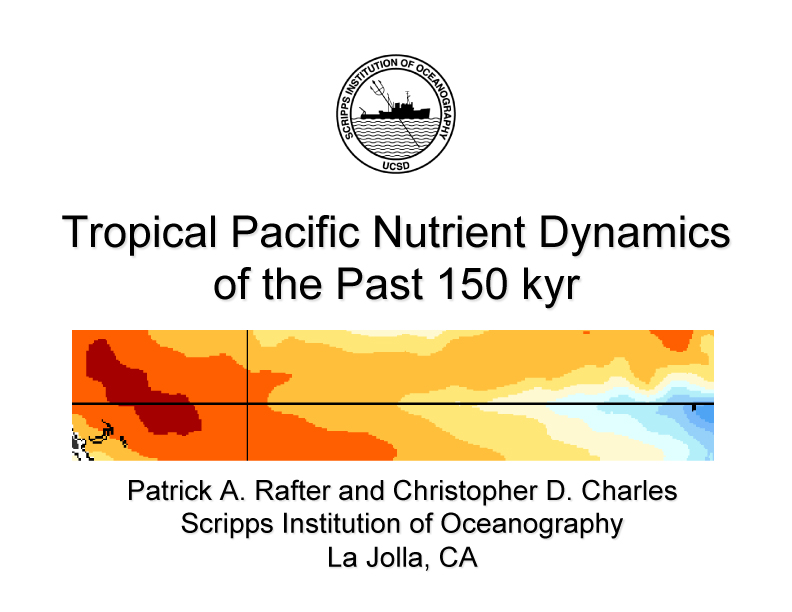 January 2016: When I first came to UC Irvine, I showed this plot to demonstrate the many nitrate isotope measurements I made in my time at Princeton. I compared these with all published measurements.
January 2016: When I first came to UC Irvine, I showed this plot to demonstrate the many nitrate isotope measurements I made in my time at Princeton. I compared these with all published measurements.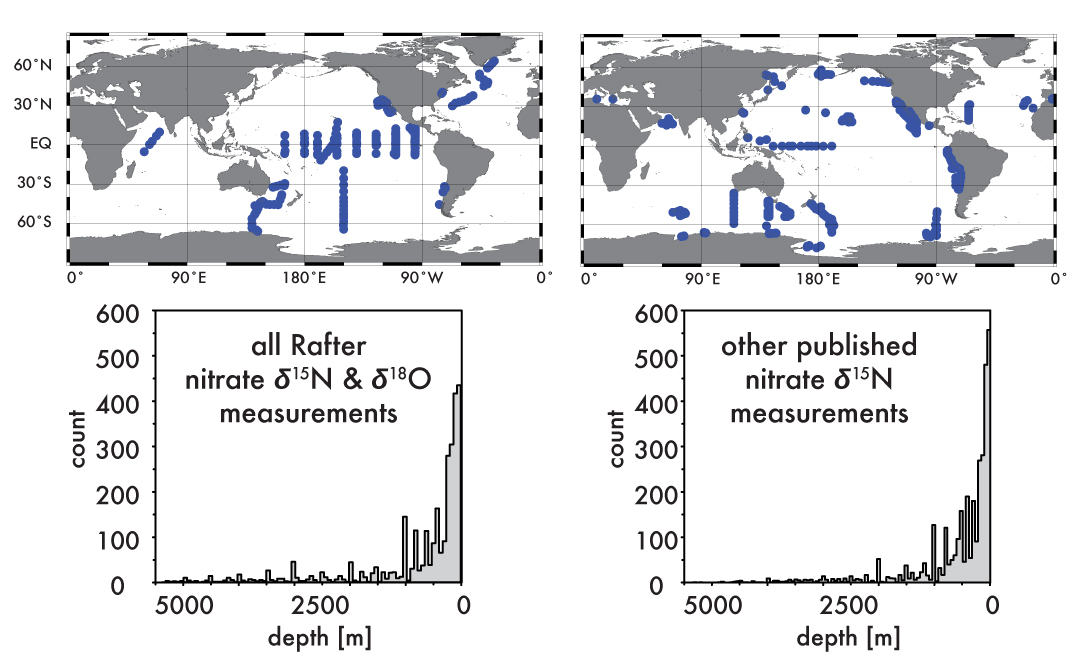 December 2015: It's all about the AGU. This year I stayed in a place just over "Grace Cathedral Hill" and walked by the self same place every night. It was gorgeous.
December 2015: It's all about the AGU. This year I stayed in a place just over "Grace Cathedral Hill" and walked by the self same place every night. It was gorgeous.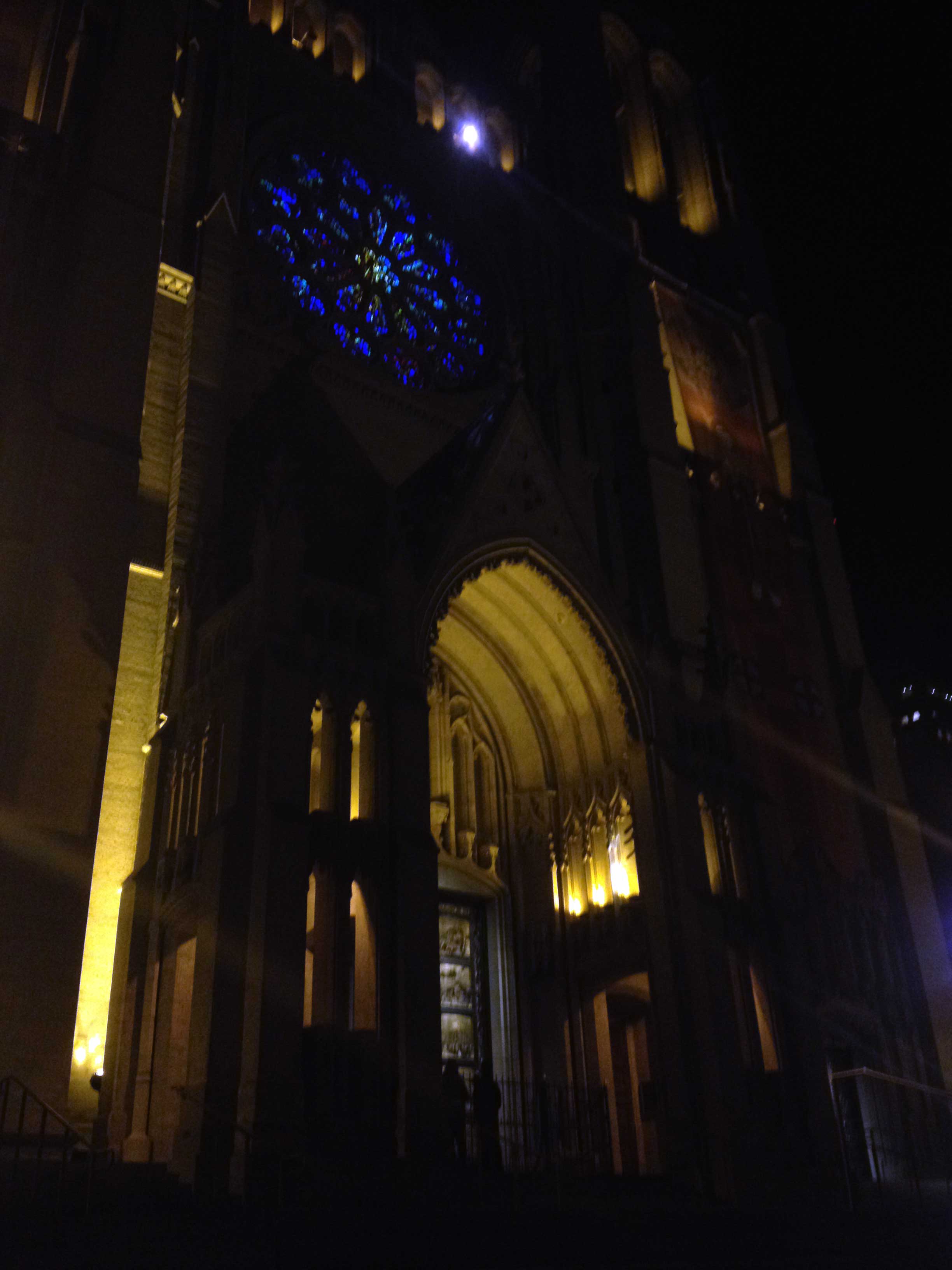 (this poor camera phone picture is barely representative)Reminded me every night of one of my favorite songs by The Decemberists. Very emo:[youtube https://www.youtube.com/watch?v=82QuFhr_ABc]Oh and the AGU meeting was as great (and overwhelming) as it always is.October 2015: Took a trip up to Stanford, CA to present my HNLC research (see below) to the great people at Stanford University. Very fun.
(this poor camera phone picture is barely representative)Reminded me every night of one of my favorite songs by The Decemberists. Very emo:[youtube https://www.youtube.com/watch?v=82QuFhr_ABc]Oh and the AGU meeting was as great (and overwhelming) as it always is.October 2015: Took a trip up to Stanford, CA to present my HNLC research (see below) to the great people at Stanford University. Very fun.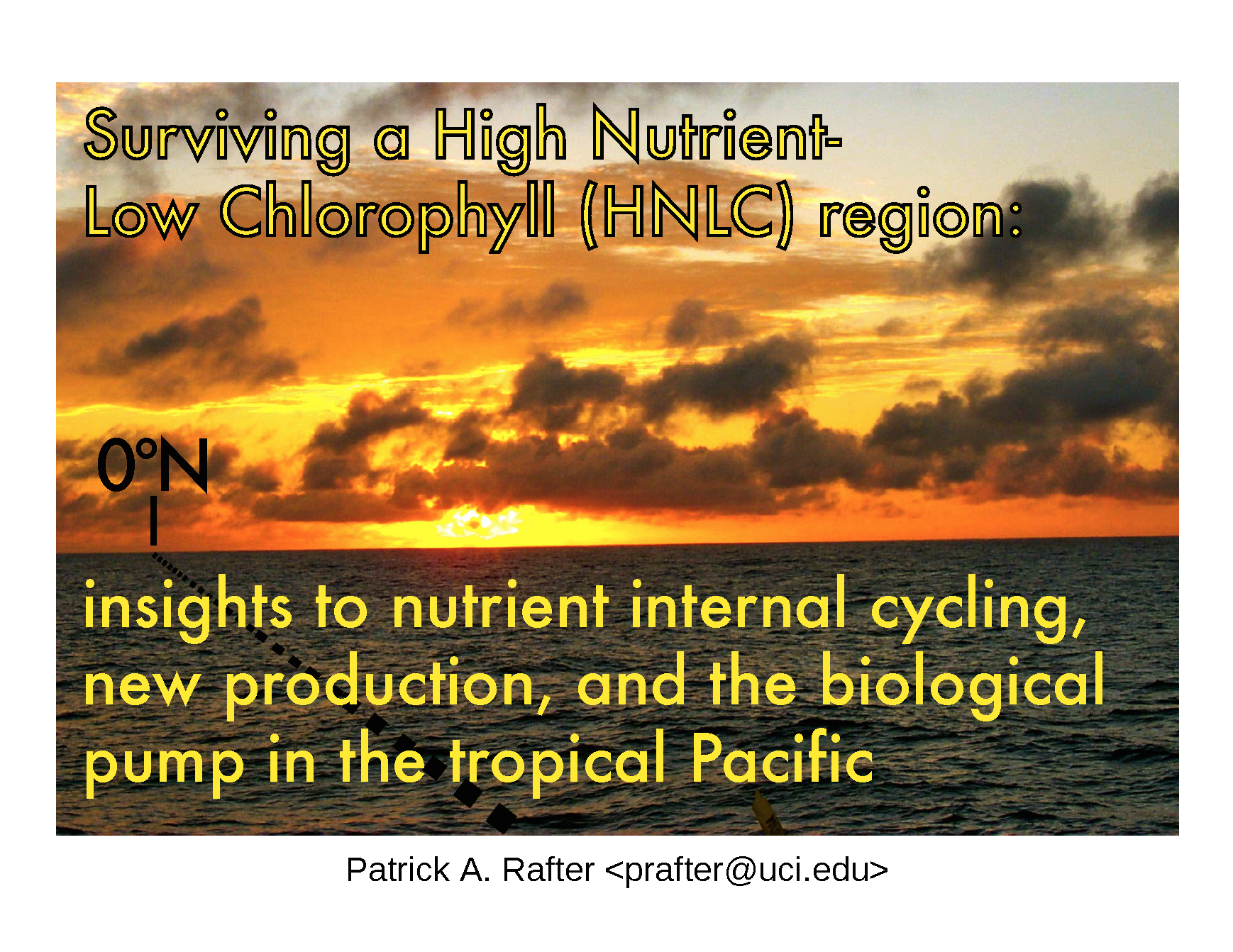 Proof I was there—PINE TREES!
Proof I was there—PINE TREES!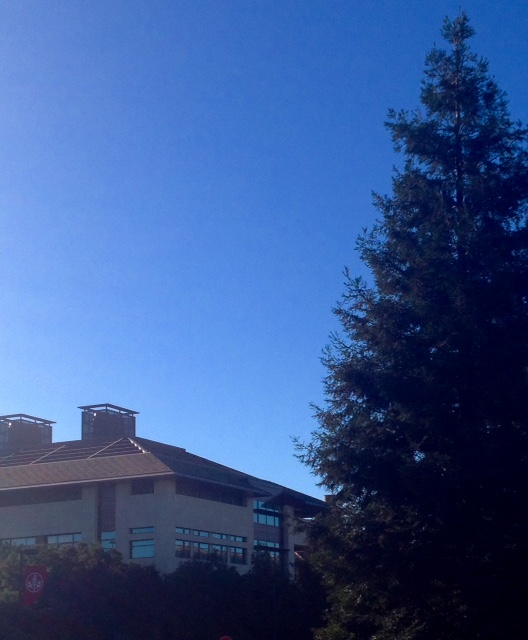 August 2015: Working up my latest paper relating nitrate consumption to iron availability in the equatorial Pacific High Nutrient-Low Chlorophyll (HNLC) region. The end result is that the observed nitrate consumption requires a good deal of internal cycling of iron.Why do we care? Because HNLC regions are places where the ocean is acting "inefficiently" with respect to carbon dioxide (CO2). In other words, places where nutrients go unused in the surface ocean (such as HNLC regions) are "missed opportunities" to resequester CO2 back into the ocean. In this paper (in preparation) we find that the observed nitrate utilization, and therefore primary produciton related to upwelling waters, requires a significant amount of iron to be recycled in the surface ocean.Compare the nitrate utilization predicted based on the available iron (in gray) with the observed nitrate utilization (colors—measured over several years). It is not possible to drive this nitrate utilization with the available iron upwelled to the surface, and we propose the additional nitrate utilization is driven by the recycling of iron.
August 2015: Working up my latest paper relating nitrate consumption to iron availability in the equatorial Pacific High Nutrient-Low Chlorophyll (HNLC) region. The end result is that the observed nitrate consumption requires a good deal of internal cycling of iron.Why do we care? Because HNLC regions are places where the ocean is acting "inefficiently" with respect to carbon dioxide (CO2). In other words, places where nutrients go unused in the surface ocean (such as HNLC regions) are "missed opportunities" to resequester CO2 back into the ocean. In this paper (in preparation) we find that the observed nitrate utilization, and therefore primary produciton related to upwelling waters, requires a significant amount of iron to be recycled in the surface ocean.Compare the nitrate utilization predicted based on the available iron (in gray) with the observed nitrate utilization (colors—measured over several years). It is not possible to drive this nitrate utilization with the available iron upwelled to the surface, and we propose the additional nitrate utilization is driven by the recycling of iron.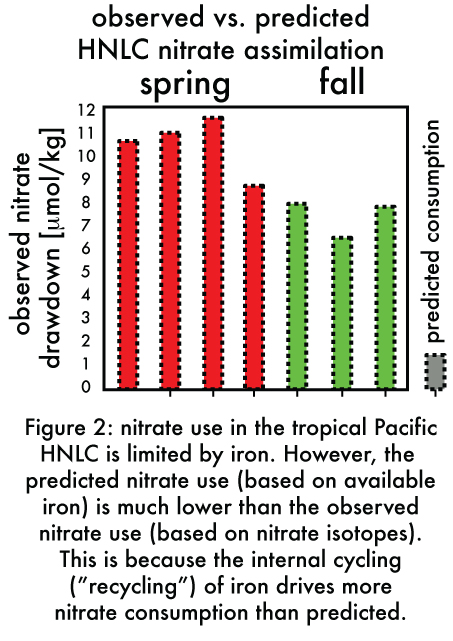 July 2015: My latest "monumental" manuscript (not my words, but after nearly 1000 measurements, I agree) is finally accepted. The lengthy review process (a year or so) at Limnology and Oceanography was useful in producing a much improved manuscript. (It didn't always feel that way, but it was!)
July 2015: My latest "monumental" manuscript (not my words, but after nearly 1000 measurements, I agree) is finally accepted. The lengthy review process (a year or so) at Limnology and Oceanography was useful in producing a much improved manuscript. (It didn't always feel that way, but it was!)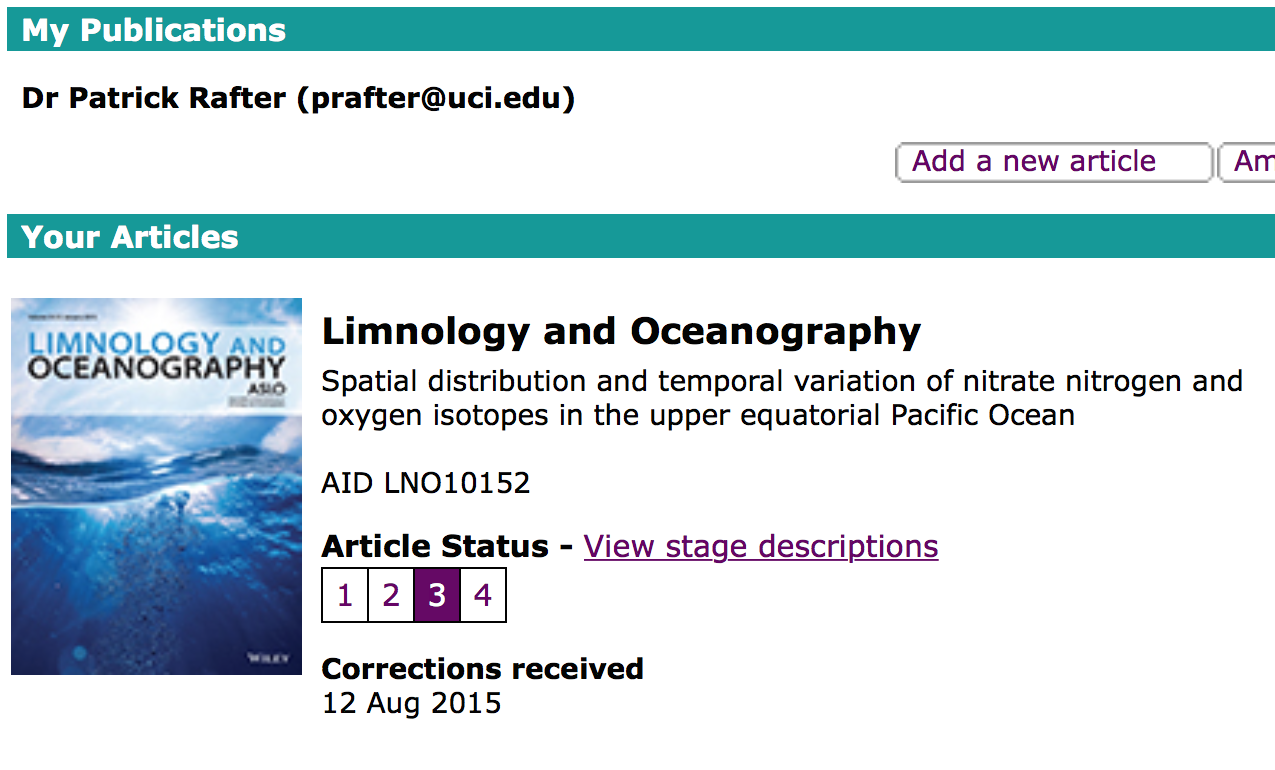 July, July, July-i-yiiiii* 2015: My favorite conference of all is the once-every-three-years Gordon Chemical Oceanography in Holderness, NH.So much good science and so many good people. My favorite talk was... well, I'm not going to say because a few of my friends gave talks (e.g., Bonnie, Seth, Tim, Tristan).
July, July, July-i-yiiiii* 2015: My favorite conference of all is the once-every-three-years Gordon Chemical Oceanography in Holderness, NH.So much good science and so many good people. My favorite talk was... well, I'm not going to say because a few of my friends gave talks (e.g., Bonnie, Seth, Tim, Tristan).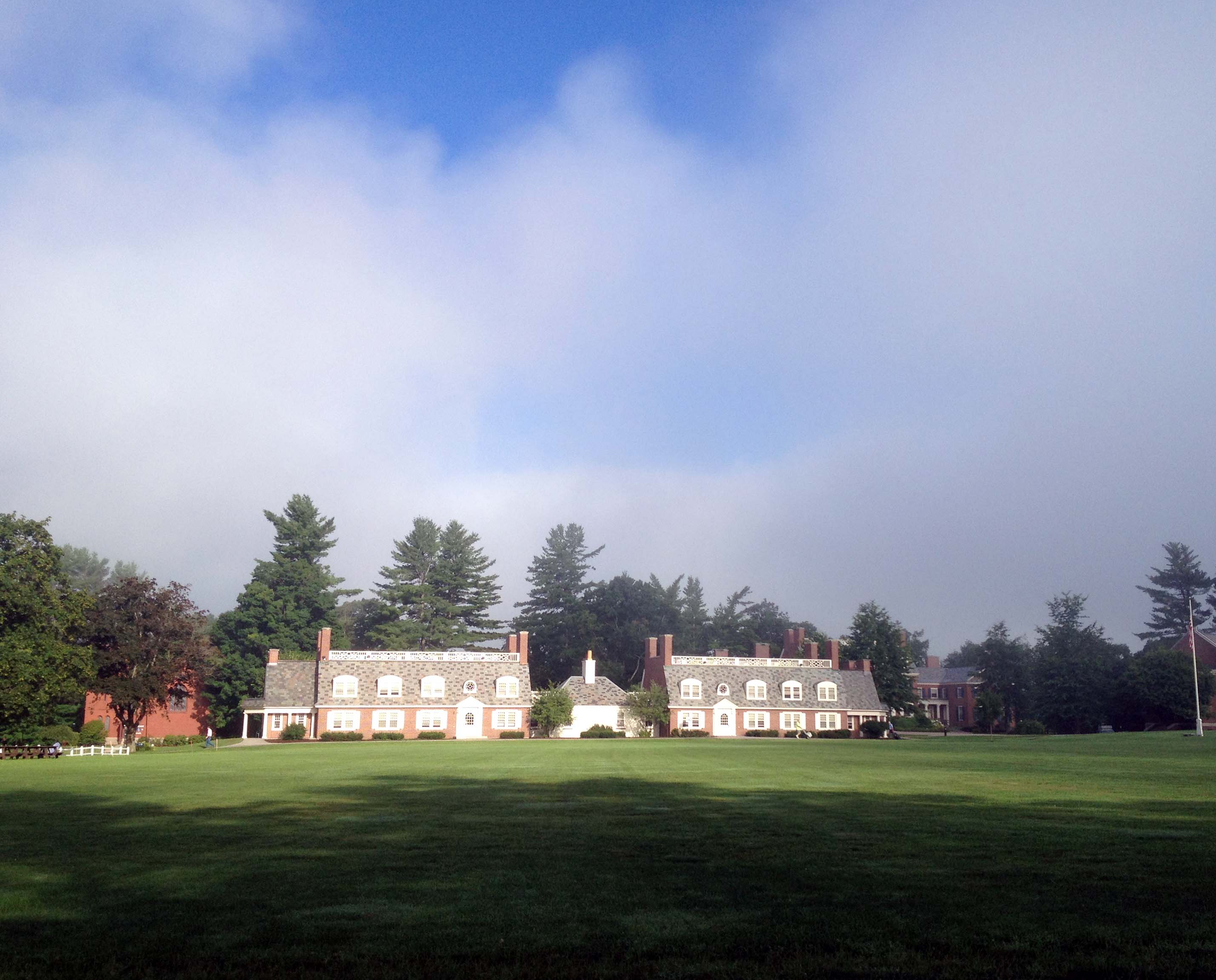 New Hampshire was green and lush and nothing like southern California.*see The Decemberists' album Castaways and Cutouts to understand this reference.April 2015: Doesn't this equation for "delta notation" (hastily written for a student) look like a face? See, science and math can be fun! What's missing? You multiply this value by 1000 so your "delta" value is in parts per thousand or "per mil". This is not, in itself, inherent to the equation even if many authors include it as such.
New Hampshire was green and lush and nothing like southern California.*see The Decemberists' album Castaways and Cutouts to understand this reference.April 2015: Doesn't this equation for "delta notation" (hastily written for a student) look like a face? See, science and math can be fun! What's missing? You multiply this value by 1000 so your "delta" value is in parts per thousand or "per mil". This is not, in itself, inherent to the equation even if many authors include it as such.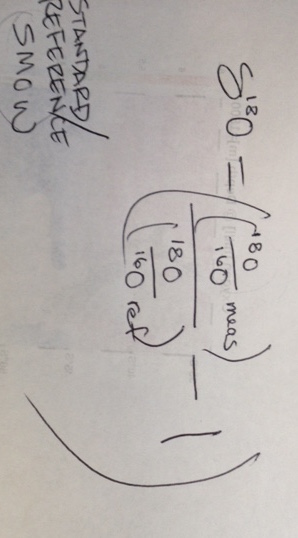
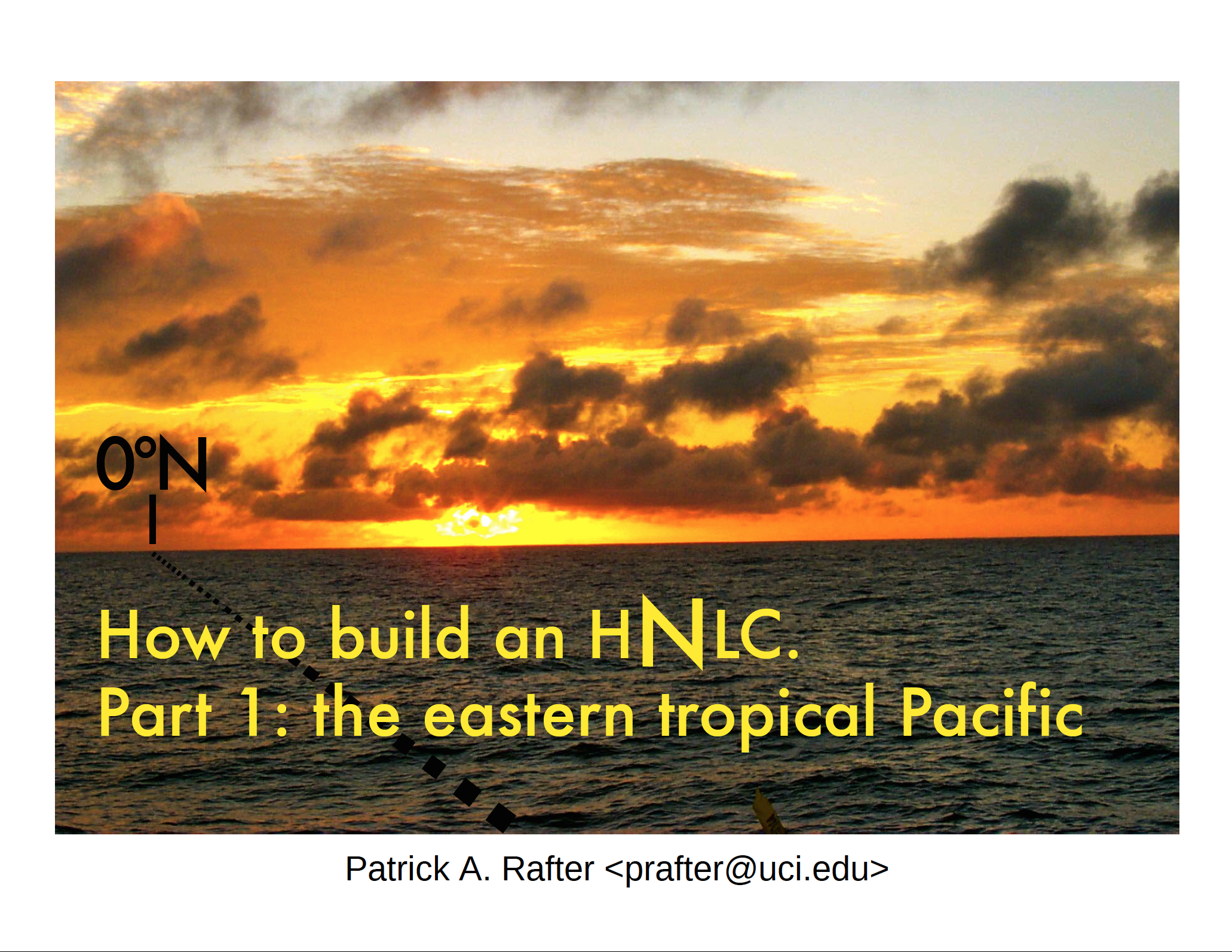
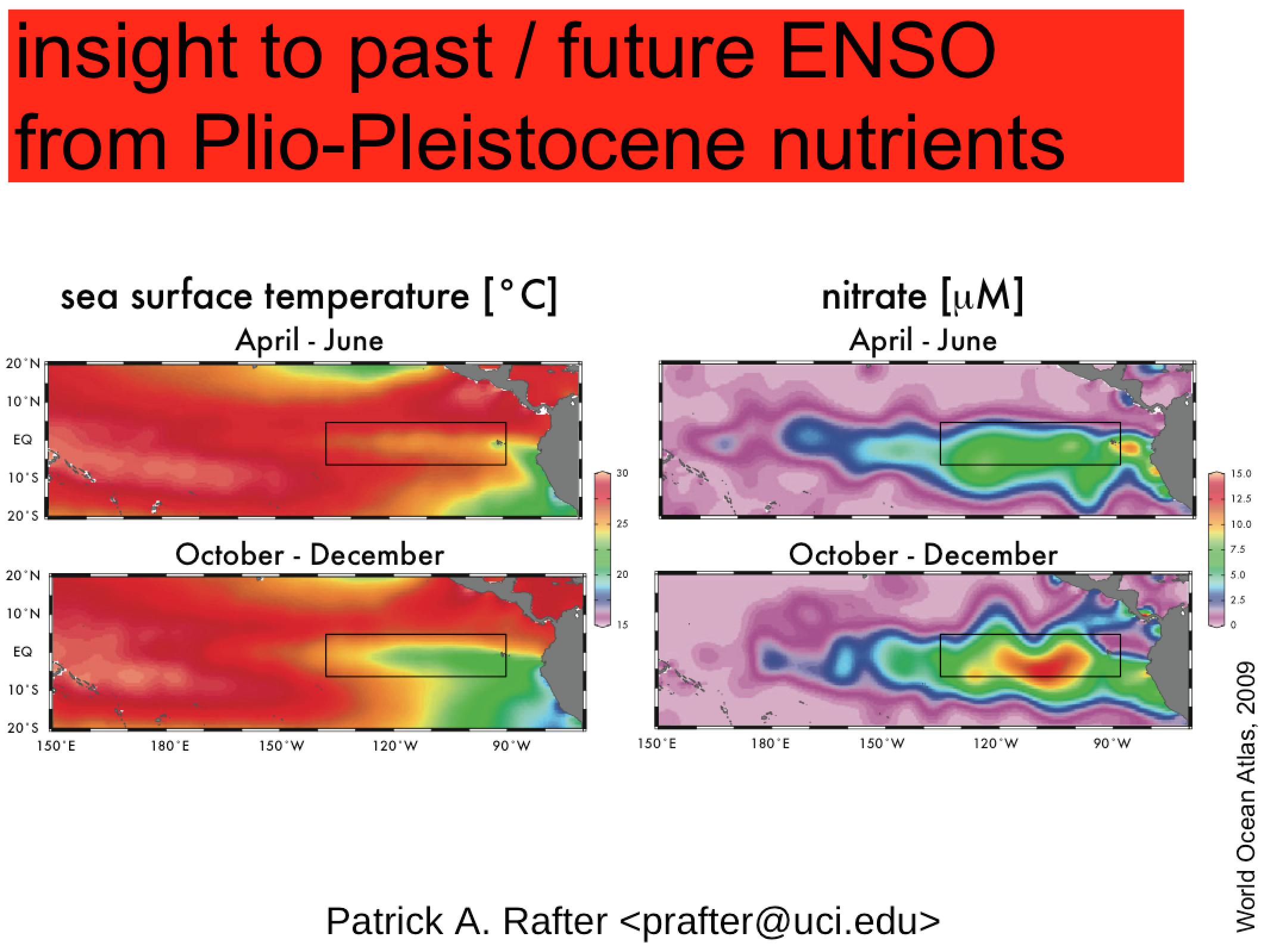
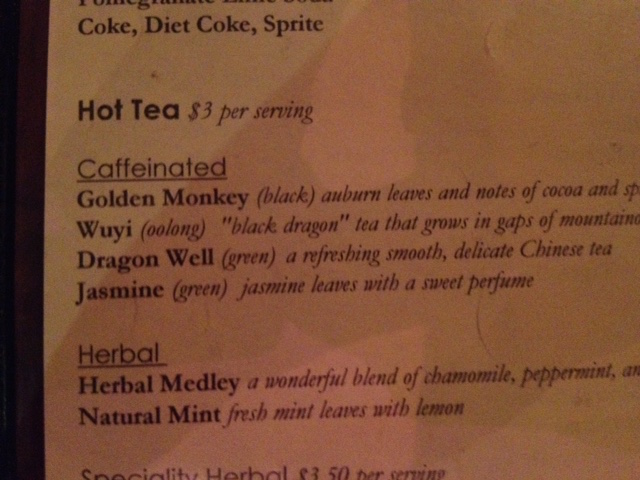
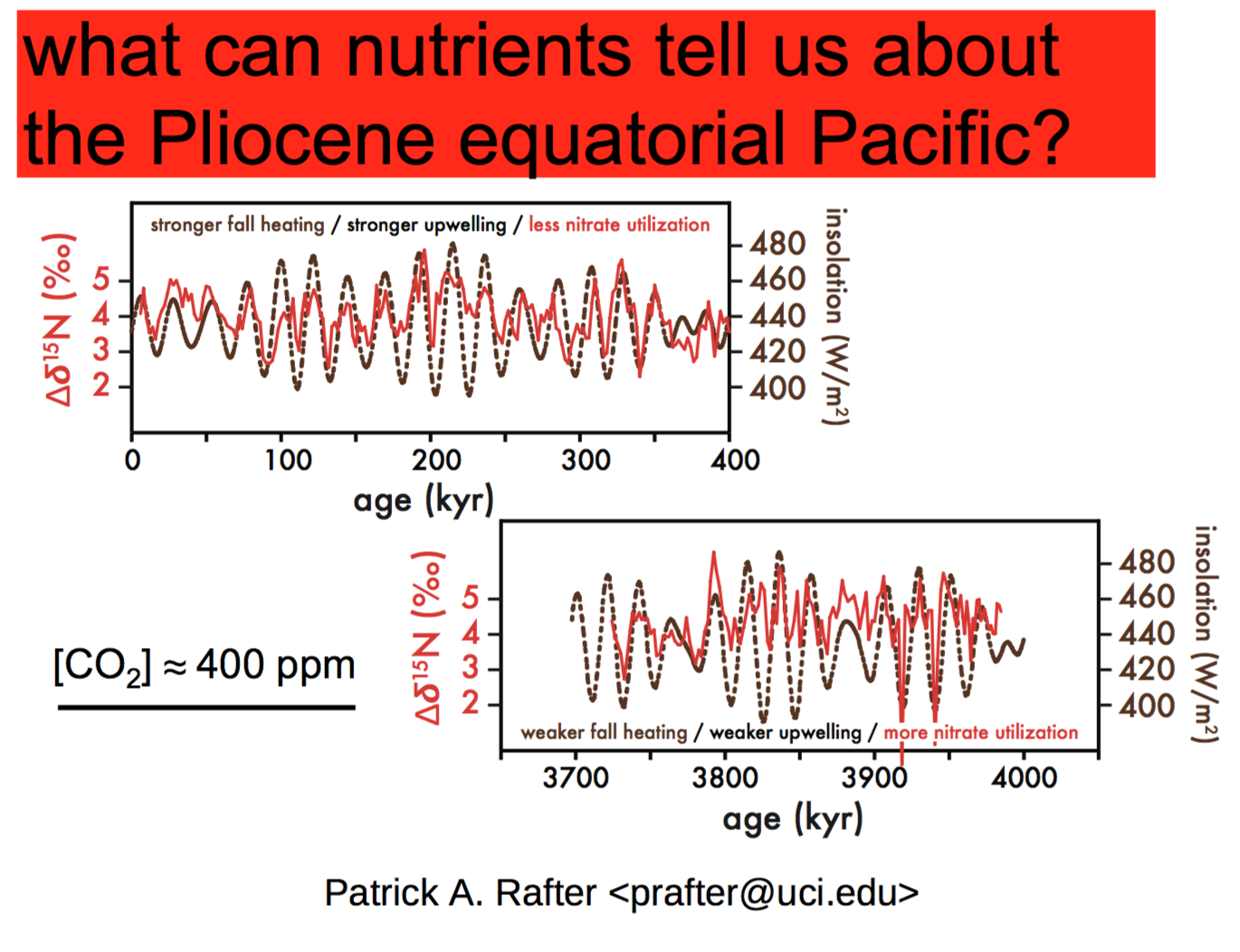
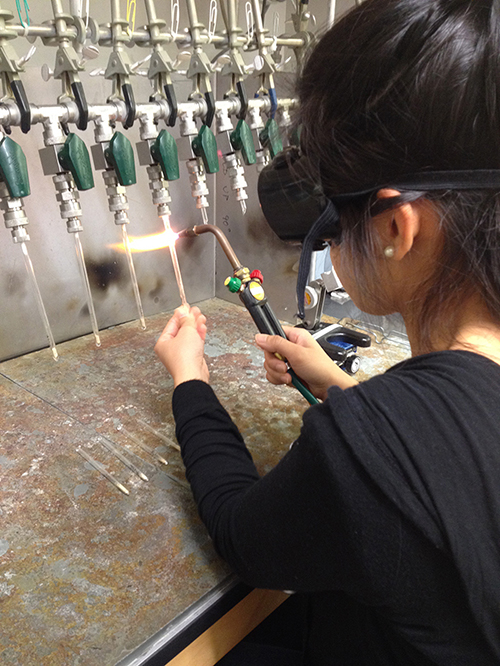
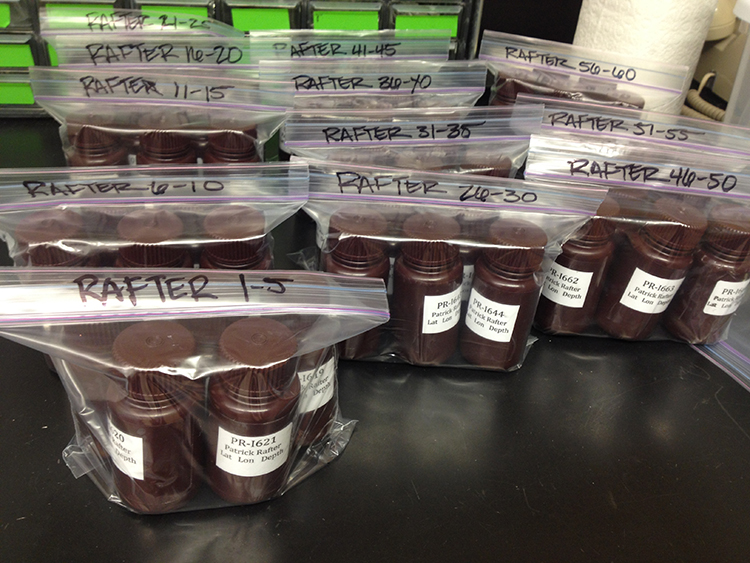
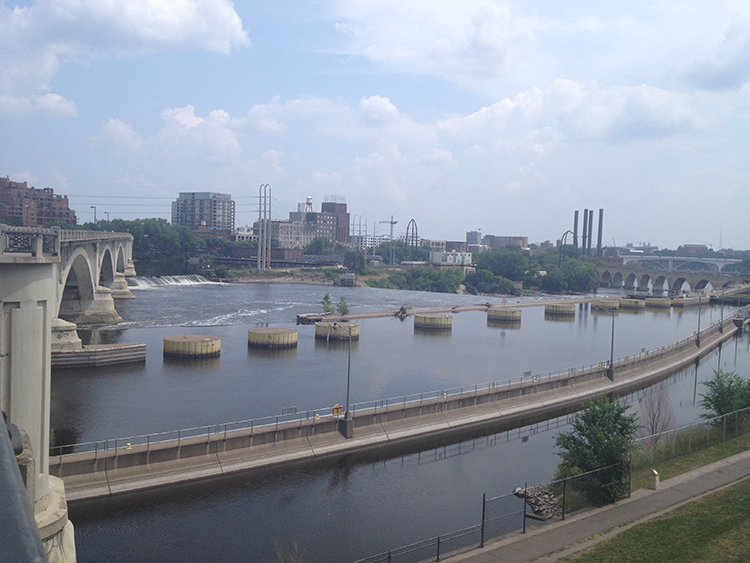
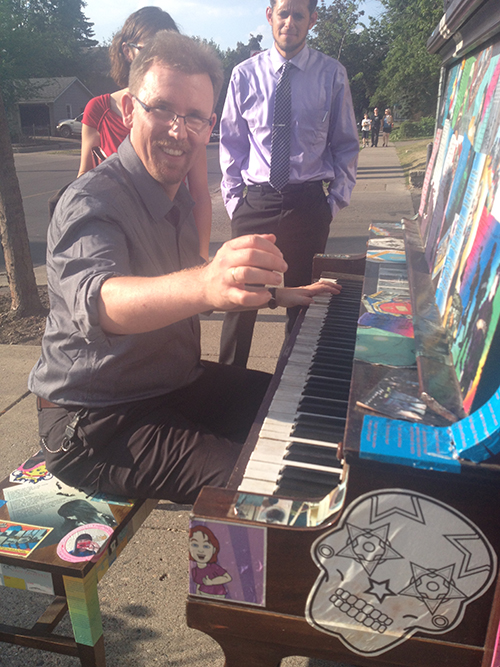
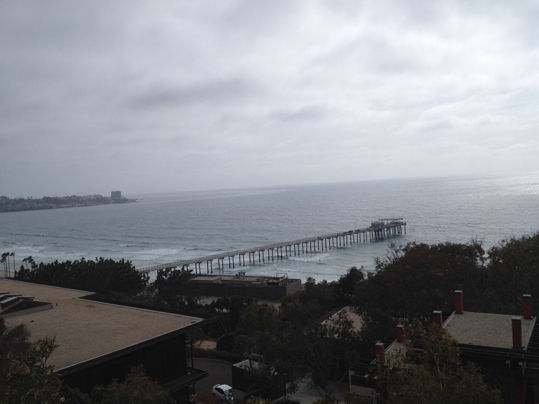
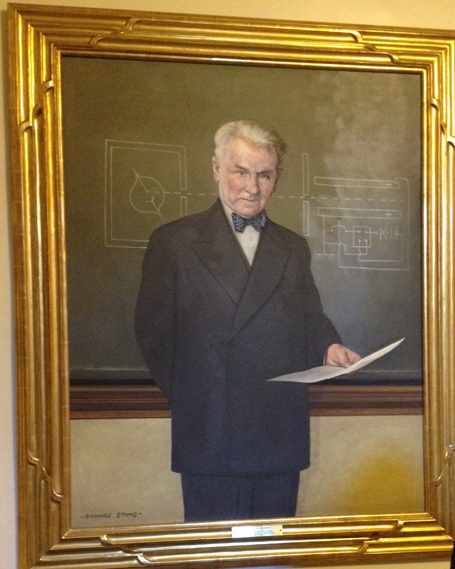 April 2014: I'm happy to call UCI and the Keck Accelerator Mass Spectrometry facility my new home!
April 2014: I'm happy to call UCI and the Keck Accelerator Mass Spectrometry facility my new home!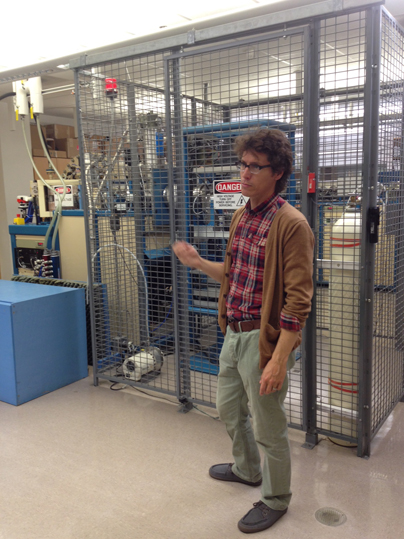 I talk with my hands a lot.(BELOW ARE POSTS FROM MY TIME AT PRINCETON UNIVERSITY)March 2014: My favorite conference is Ocean Sciences and this year it was in Hawai'i. I had a great time giving a talk to on Pliocene nutrient dynamics. And my friends Adam and Andre picked me and gave me a legitimate Aloha welcome to Hawai'i with a Kekui nut lei.
I talk with my hands a lot.(BELOW ARE POSTS FROM MY TIME AT PRINCETON UNIVERSITY)March 2014: My favorite conference is Ocean Sciences and this year it was in Hawai'i. I had a great time giving a talk to on Pliocene nutrient dynamics. And my friends Adam and Andre picked me and gave me a legitimate Aloha welcome to Hawai'i with a Kekui nut lei. It was a long flight and I was about to go surfing, so please excuse my appearance.
It was a long flight and I was about to go surfing, so please excuse my appearance.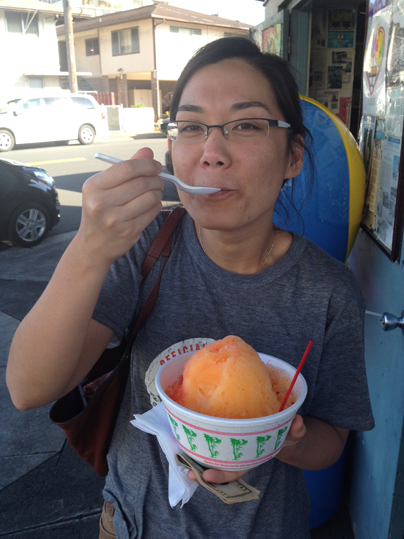 Shave ice is a local delicacy and I enjoyed some with the brilliant scientist Bonnie Chang (now at University of Washington)February 2014: I had a great visit to Lamont yesterday to talk about Pliocene equatorial Pacific nutrient dynamics.It was the day before our last huge snowstorm and here's a photo of the new LDEO building (and Wally's really nice office):
Shave ice is a local delicacy and I enjoyed some with the brilliant scientist Bonnie Chang (now at University of Washington)February 2014: I had a great visit to Lamont yesterday to talk about Pliocene equatorial Pacific nutrient dynamics.It was the day before our last huge snowstorm and here's a photo of the new LDEO building (and Wally's really nice office):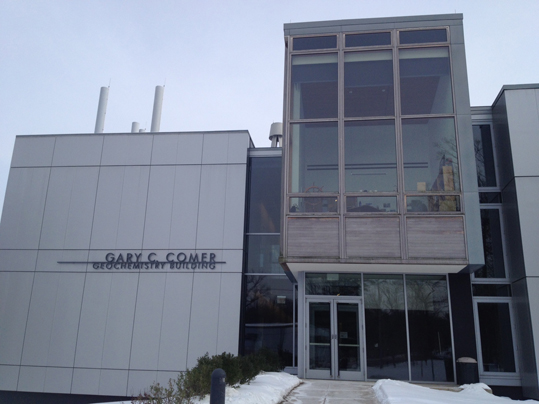
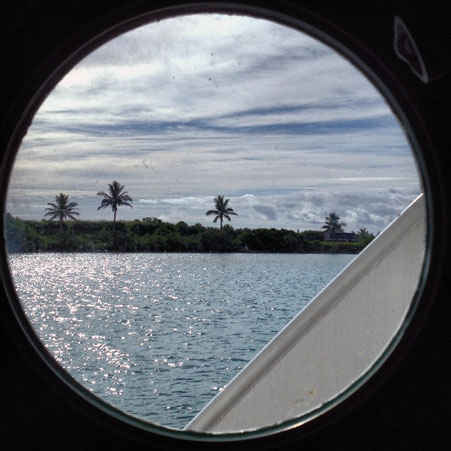
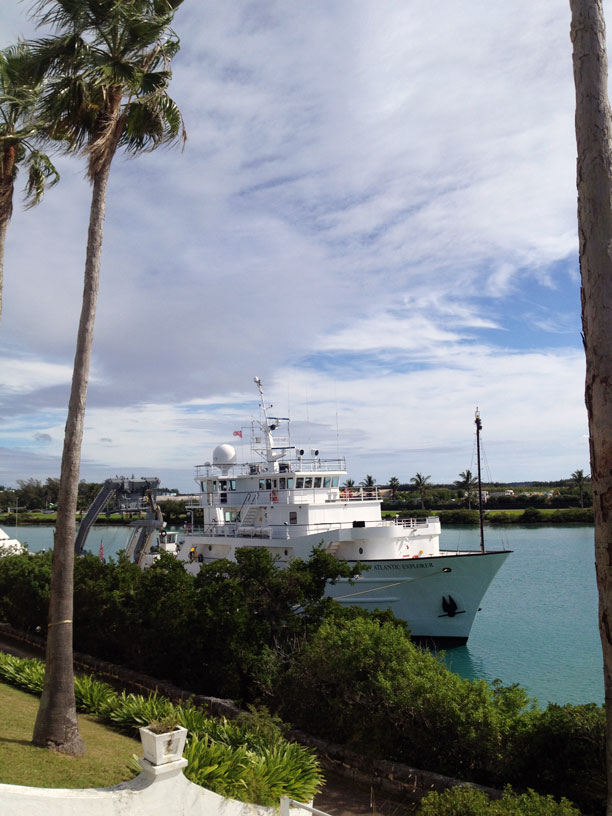
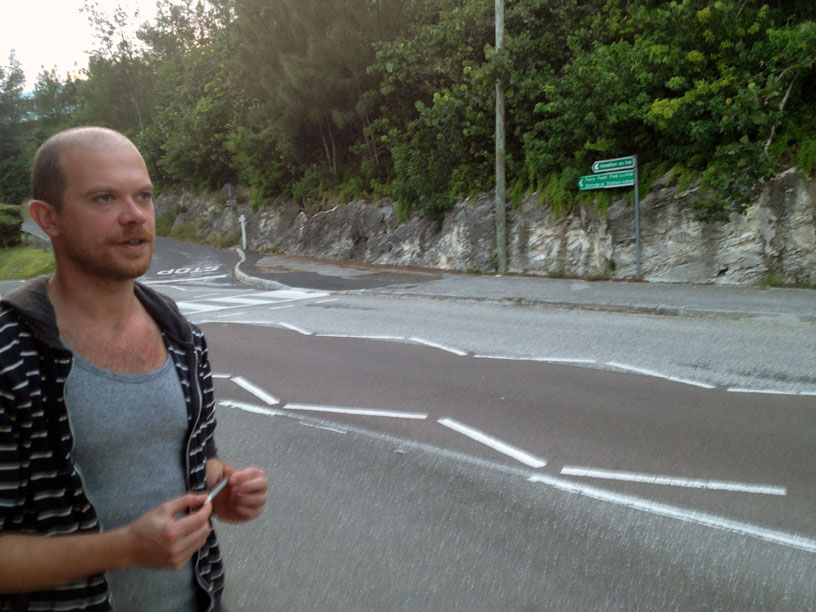 November 2013: If it's November, I must be preparing for another research cruise... actually, "cruises" plural. First, to prepare 400 bottles for the CalCOFI program (muchas gracias!) and then I have to prepare myself (and a bunch of gear) for another cruise to the Bermuda Triangle with the BATS program. Hope there aren't 25 foot seas this time...
November 2013: If it's November, I must be preparing for another research cruise... actually, "cruises" plural. First, to prepare 400 bottles for the CalCOFI program (muchas gracias!) and then I have to prepare myself (and a bunch of gear) for another cruise to the Bermuda Triangle with the BATS program. Hope there aren't 25 foot seas this time...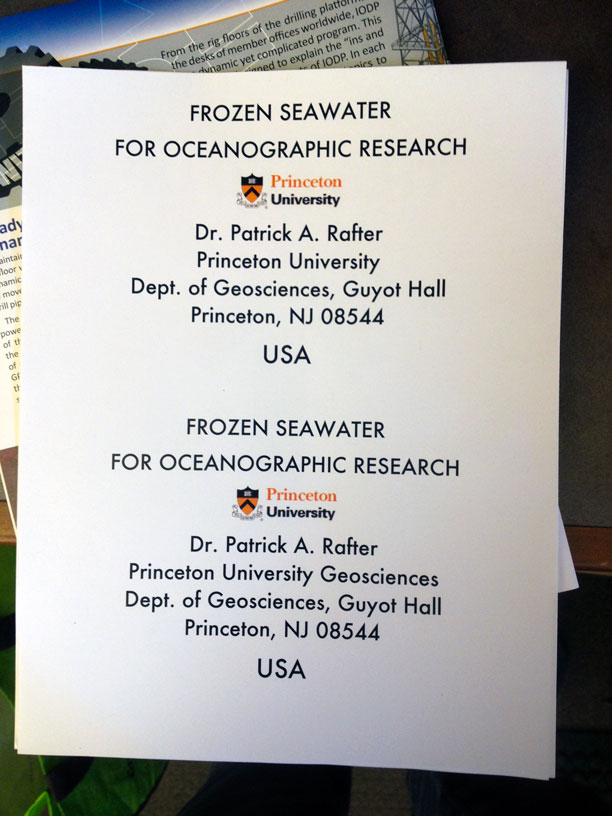 I hope that it helps to put "Dr." before your name when you have grumpy baggage handlers and the like looking over the strangely heavy cooler (it's full of seawater! look at the label!). Maybe the PU logo also helps.October 2013: My tour of the northeast continues, with a stop over at Yale to talk about my paleoceanographic work. Had some great discussions with Pincelli Hull, Yige Zhang, Alexey Fedorov (great questions), some others I've forgotten their names (sorry!), and a surprise appearance by Gavin Foster who was on sabatical.Really great architecture on campus too... slightly better than Princeton actually. Although it was a little strang to see the campus integrated into the town (public roads throughout). Not bad, just different.You had to watch where you were walking or you'd get run over by a bus.
I hope that it helps to put "Dr." before your name when you have grumpy baggage handlers and the like looking over the strangely heavy cooler (it's full of seawater! look at the label!). Maybe the PU logo also helps.October 2013: My tour of the northeast continues, with a stop over at Yale to talk about my paleoceanographic work. Had some great discussions with Pincelli Hull, Yige Zhang, Alexey Fedorov (great questions), some others I've forgotten their names (sorry!), and a surprise appearance by Gavin Foster who was on sabatical.Really great architecture on campus too... slightly better than Princeton actually. Although it was a little strang to see the campus integrated into the town (public roads throughout). Not bad, just different.You had to watch where you were walking or you'd get run over by a bus.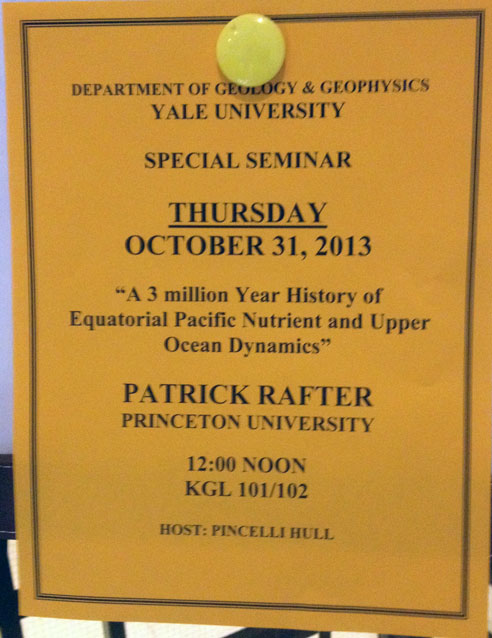
 October 2013: I had another great visit to Woods Hole Oceanographic Institution (WHOI) this past week—this time to present a small part of my recently published nitrate isotope work from the South Pacific (LINK HERE). It is beautiful up in Cape Cod this time of year, but I somehow was unable to take a good picture of the fall foliage, so you are left with this:
October 2013: I had another great visit to Woods Hole Oceanographic Institution (WHOI) this past week—this time to present a small part of my recently published nitrate isotope work from the South Pacific (LINK HERE). It is beautiful up in Cape Cod this time of year, but I somehow was unable to take a good picture of the fall foliage, so you are left with this: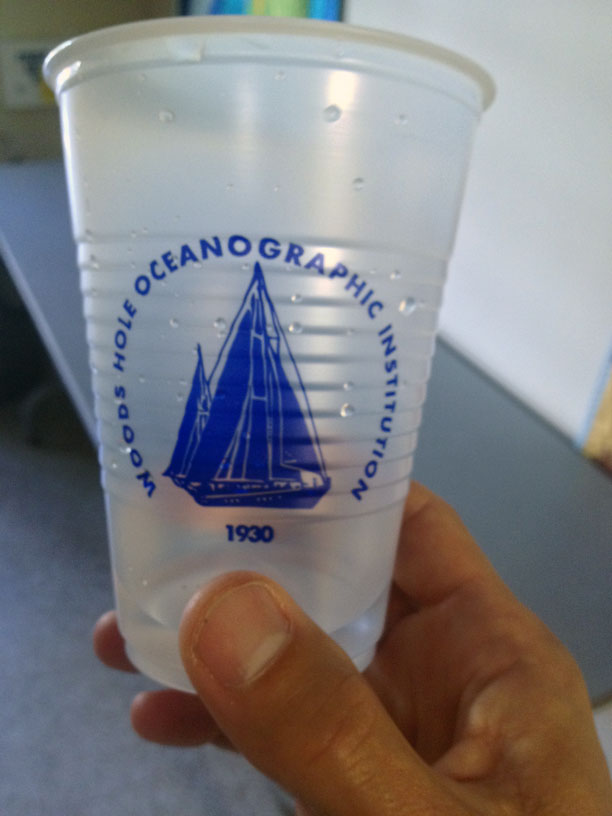 My thanks to Roo Nicholson, Mak Saito, Kris Karnauskas, Steve Beaupre, Carly Buchwald, Jessica Tierney, Kevin Anchukaitis, Carl Lamborg and others who talked science with me while I was there. (Additional thanks to David Clark for allowing me to stay in his really great house in the woods while he is away.) Next stop is Yale on October 31st.September 2013: This is a little after-the-fact, but I had a great time presenting at Goldschmidt and ICP in the past few weeks. Here are some photos from my trips to Italy and Spain.
My thanks to Roo Nicholson, Mak Saito, Kris Karnauskas, Steve Beaupre, Carly Buchwald, Jessica Tierney, Kevin Anchukaitis, Carl Lamborg and others who talked science with me while I was there. (Additional thanks to David Clark for allowing me to stay in his really great house in the woods while he is away.) Next stop is Yale on October 31st.September 2013: This is a little after-the-fact, but I had a great time presenting at Goldschmidt and ICP in the past few weeks. Here are some photos from my trips to Italy and Spain.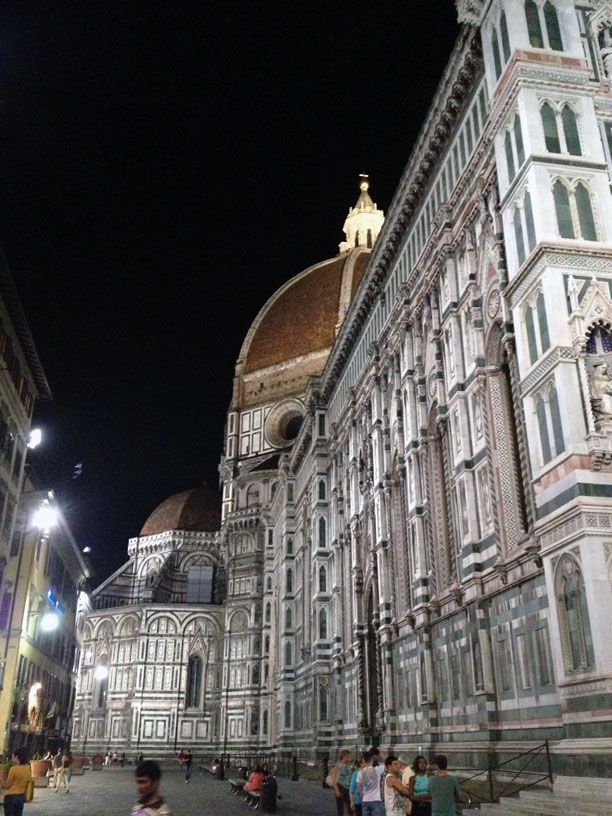 Florence has a lot of really old stuff (especially to this young American)
Florence has a lot of really old stuff (especially to this young American)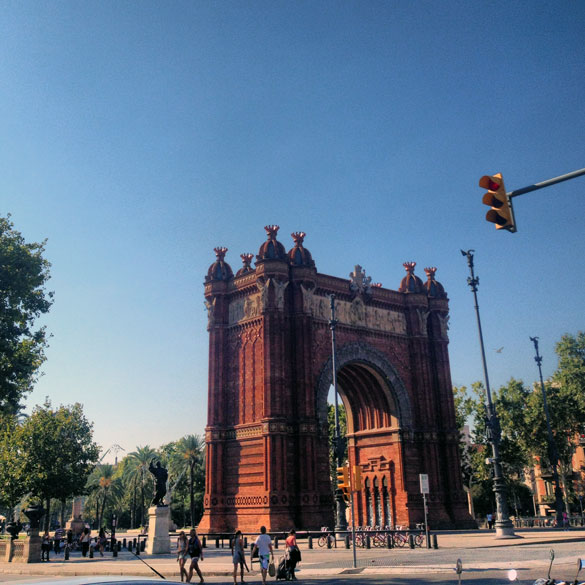 My first view upon entering Barcelona. Pretty fantastic.
My first view upon entering Barcelona. Pretty fantastic.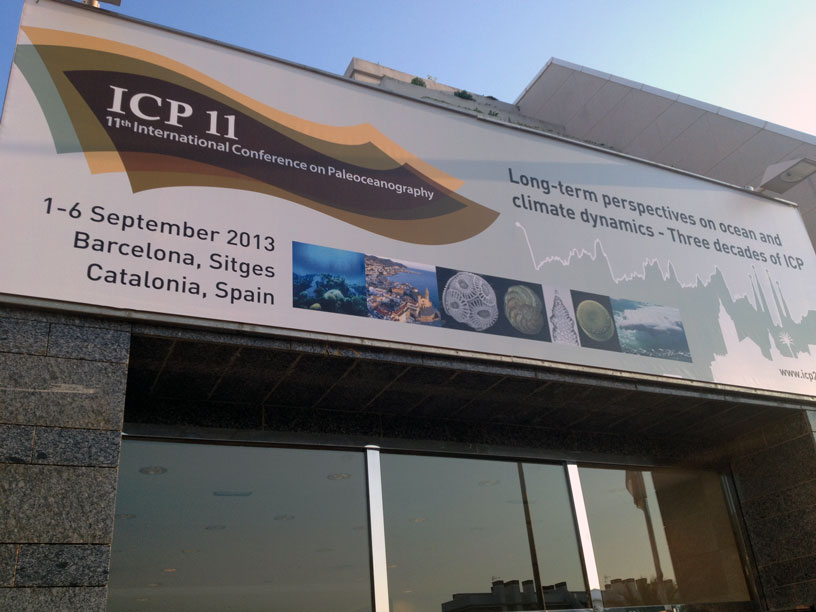 Not to be confused with the band ICP, the International Conference on Paleoceanography is serious business. This time, in a very fun town on the Mediterranean coast (Sitges: pronounced, "Sit-Jezz").
Not to be confused with the band ICP, the International Conference on Paleoceanography is serious business. This time, in a very fun town on the Mediterranean coast (Sitges: pronounced, "Sit-Jezz").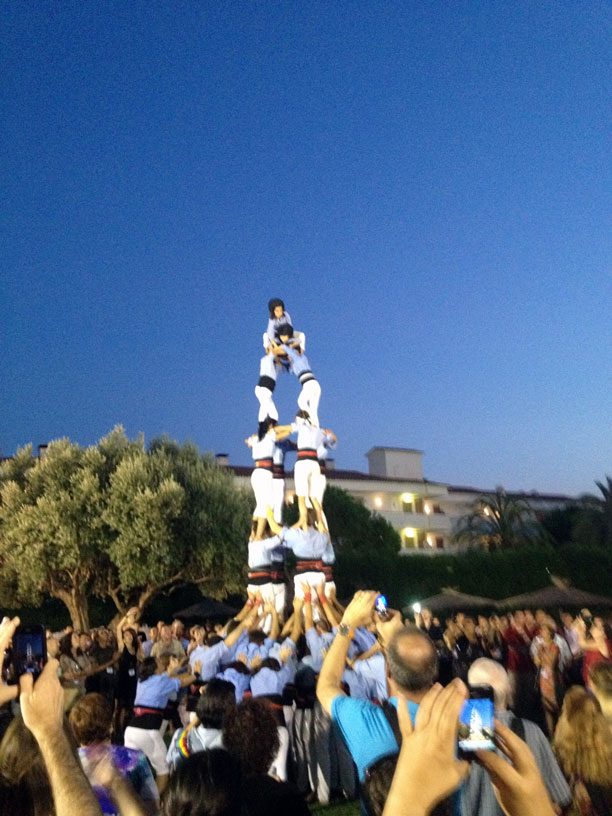 Human "castell" (or "castle") is a tradition of Catalonia, which is the broader region of Spain we were staying in.Finally, I need to mention that my favorite refreshment is horchata, which in Mexico is rice milk with cinnamon (and accompanies a burrito very well). Well, I was informed by my friend Alfredo that horchata is originally from his region of Spain (Valencia). The name derives from something a Spanish nobleman exclaimed upon first drinking the beverage (roughly translated as "This is GOLD, young lady!"). Because Barcelona is not too far from this mythical land of horchata's birth, I sought out many glasses... and here it is. They don't use rice and it lacks cinammon, but it is also delicious (if a bit gritty and thick):
Human "castell" (or "castle") is a tradition of Catalonia, which is the broader region of Spain we were staying in.Finally, I need to mention that my favorite refreshment is horchata, which in Mexico is rice milk with cinnamon (and accompanies a burrito very well). Well, I was informed by my friend Alfredo that horchata is originally from his region of Spain (Valencia). The name derives from something a Spanish nobleman exclaimed upon first drinking the beverage (roughly translated as "This is GOLD, young lady!"). Because Barcelona is not too far from this mythical land of horchata's birth, I sought out many glasses... and here it is. They don't use rice and it lacks cinammon, but it is also delicious (if a bit gritty and thick):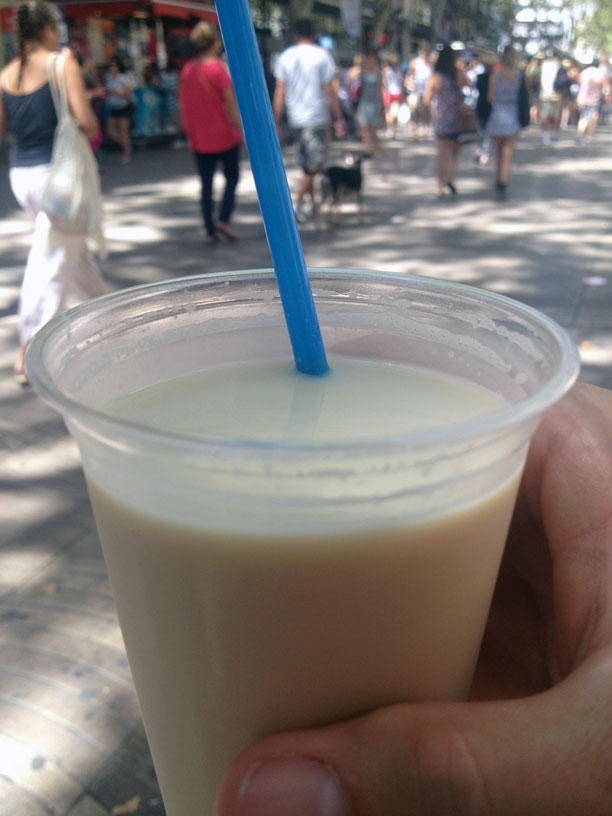 September 2013: I'm in France, performing some oceanographic research after the International Conference on Paleoceanography meeting in Sitges, Catalonia, Spain. It was great.August 2013 (2/2): I'm afraid I might be nearing saturation in this one session at the upcoming Goldschmidt Geochemistry conference in Florence, Italy...
September 2013: I'm in France, performing some oceanographic research after the International Conference on Paleoceanography meeting in Sitges, Catalonia, Spain. It was great.August 2013 (2/2): I'm afraid I might be nearing saturation in this one session at the upcoming Goldschmidt Geochemistry conference in Florence, Italy...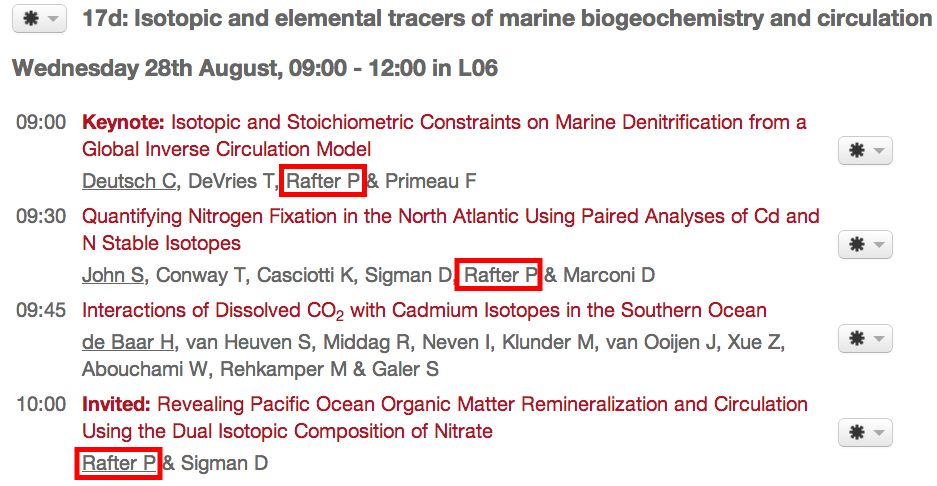 August 2013 (1/2): My good friend Scott Soens (who is a well known photographer among other things) asked me to host the High Tides Memorial Fund "Movie Night" and I (of course) accepted. High Tides is an organization based out of my hometown of Avalon, NJ whose goal is to help families suffering from pediatric cancer. It was started by fellow Avalonian Lydia Borek to honor her son Brendan—a fellow surfer—who died from Ewing's Sarcoma. I was there for the first fund raiser / surf contest / Brendan's birthday party 23 years ago and I've been there every year since.Back to the story, Movie Night entails the showing of a surf movie the night before the big surf contest and I chose the movie This Time Tomorrow, a movie where 2 surfers follow a swell from Australia to Alaska. It's a pretty cool story with great surfing and I led off the night with a brief lecture on how waves are formed and how it is possible to ride the "same wave" in Australia and Alaska (at least, theoretically possible). The lecture was titled:
August 2013 (1/2): My good friend Scott Soens (who is a well known photographer among other things) asked me to host the High Tides Memorial Fund "Movie Night" and I (of course) accepted. High Tides is an organization based out of my hometown of Avalon, NJ whose goal is to help families suffering from pediatric cancer. It was started by fellow Avalonian Lydia Borek to honor her son Brendan—a fellow surfer—who died from Ewing's Sarcoma. I was there for the first fund raiser / surf contest / Brendan's birthday party 23 years ago and I've been there every year since.Back to the story, Movie Night entails the showing of a surf movie the night before the big surf contest and I chose the movie This Time Tomorrow, a movie where 2 surfers follow a swell from Australia to Alaska. It's a pretty cool story with great surfing and I led off the night with a brief lecture on how waves are formed and how it is possible to ride the "same wave" in Australia and Alaska (at least, theoretically possible). The lecture was titled: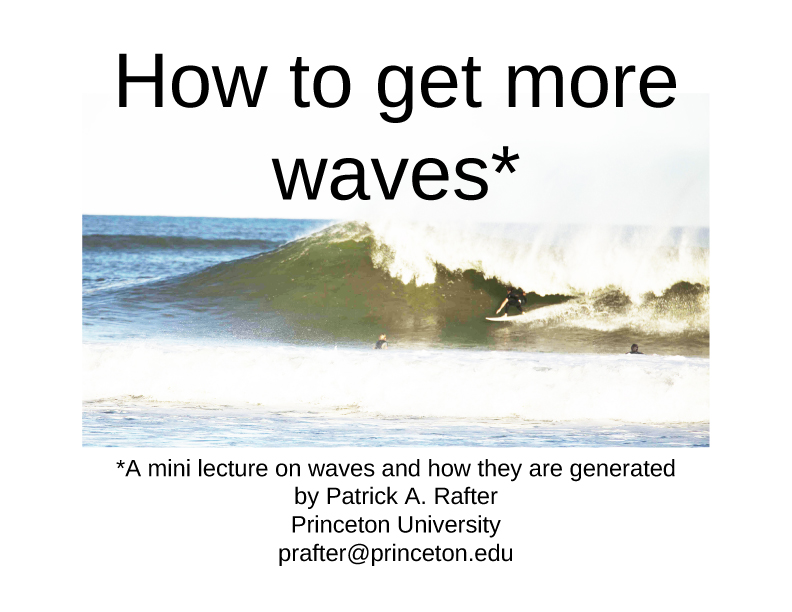 It was a good time and I got to give out free stuff to all the surf grommets who attended.July 2013: The "In Press" version of my latest paper is available for downloadhere. It's a good read, so enjoy.
It was a good time and I got to give out free stuff to all the surf grommets who attended.July 2013: The "In Press" version of my latest paper is available for downloadhere. It's a good read, so enjoy.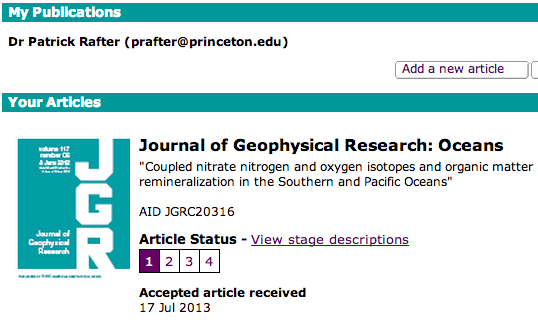 I'll be presenting these and newer measurements from one of Mak Saito's tropical Pacific cruises at Goldschmidt next month in Florence, Italy.May 2013 (2/2): I also had a fruitful visit to WHOI, where I presented the results from my Paleoceanograpy paper. It was my first time and I was happy to have excellent weather and to see how pretty the area is:
I'll be presenting these and newer measurements from one of Mak Saito's tropical Pacific cruises at Goldschmidt next month in Florence, Italy.May 2013 (2/2): I also had a fruitful visit to WHOI, where I presented the results from my Paleoceanograpy paper. It was my first time and I was happy to have excellent weather and to see how pretty the area is: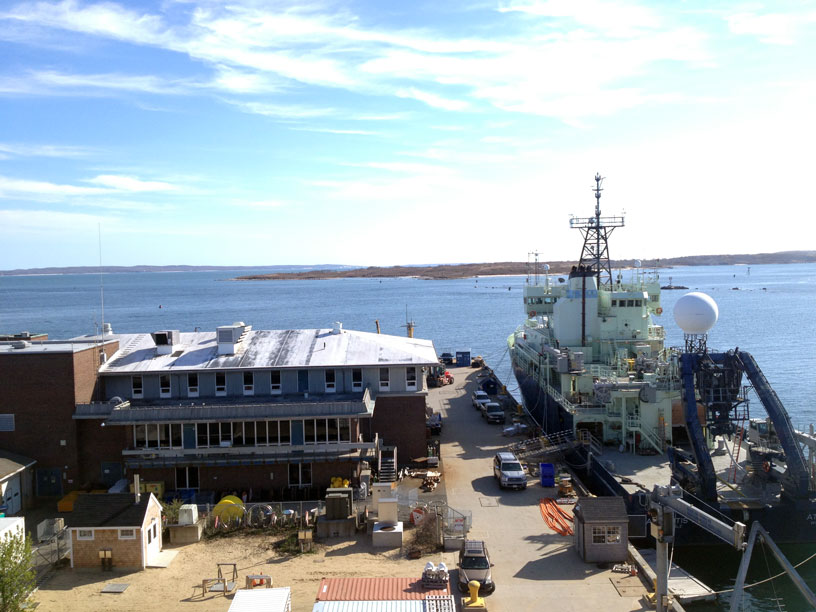 May 2013 (1/2): Super excited to say that I've got another paper in the final rounds of review—this time in the Journal of Geophysical Research-Oceans. It should be available for download within a month or so, but here's a sneak preview:
May 2013 (1/2): Super excited to say that I've got another paper in the final rounds of review—this time in the Journal of Geophysical Research-Oceans. It should be available for download within a month or so, but here's a sneak preview: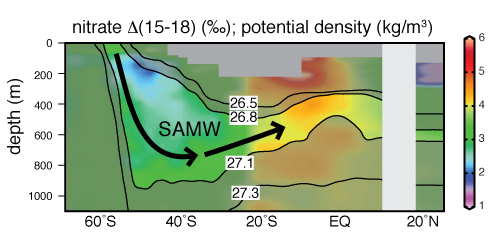 Nitrate D(15-18) is simply the difference between nitrate d15N and nitrate d18O. This tells us something specific about the remineralization of organic matter in the water column. There's a lot more to the story, of course, but I would need (and have needed) an entire paper to tell the story!April 2013: If it's April, it might be time to return to Bermuda—and so it was. This time, a solo trip. Starting in NJ, a flight to Bermuda, then aboard the good old RV Atlantic Explorer to the Bermuda Atlantic Time Series (BATS) location (a day's trip southeast of Bermuda).7 days out at sea, total.Some images:
Nitrate D(15-18) is simply the difference between nitrate d15N and nitrate d18O. This tells us something specific about the remineralization of organic matter in the water column. There's a lot more to the story, of course, but I would need (and have needed) an entire paper to tell the story!April 2013: If it's April, it might be time to return to Bermuda—and so it was. This time, a solo trip. Starting in NJ, a flight to Bermuda, then aboard the good old RV Atlantic Explorer to the Bermuda Atlantic Time Series (BATS) location (a day's trip southeast of Bermuda).7 days out at sea, total.Some images: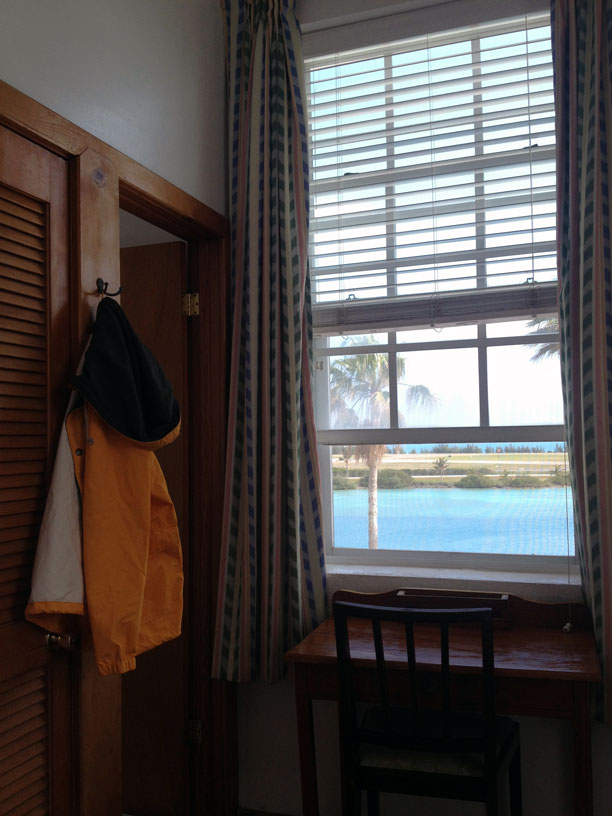 The view from my room—a quite nice room this time around
The view from my room—a quite nice room this time around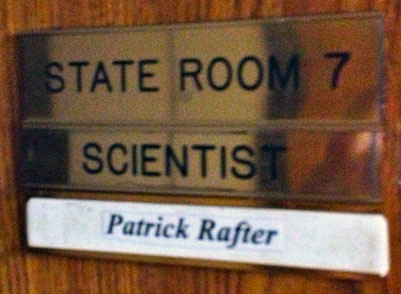
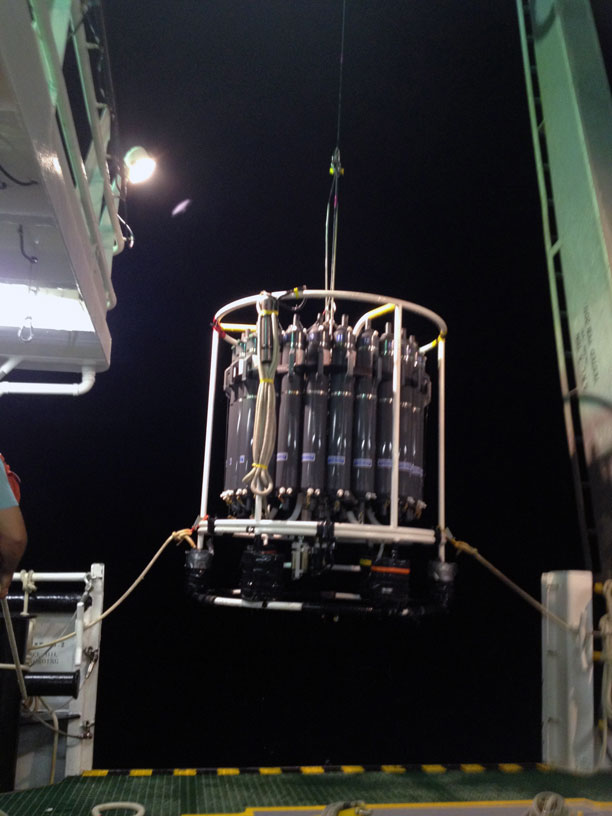 This is what's known in the oceanographic community as "recovering the CTD". As usual, a lot of night-work on the AE.
This is what's known in the oceanographic community as "recovering the CTD". As usual, a lot of night-work on the AE.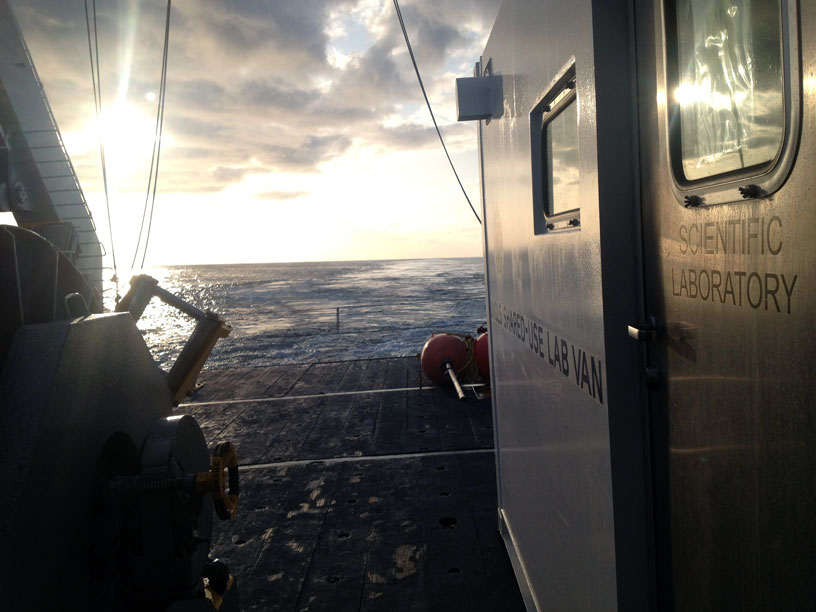 And the night time work often leads into early morning chill-out sessions before headed to your cabin for some much needed shut-eye. Here we see sunrise reflecting off the "science van" on the back deck of the AE.
And the night time work often leads into early morning chill-out sessions before headed to your cabin for some much needed shut-eye. Here we see sunrise reflecting off the "science van" on the back deck of the AE. Click to make bigger. The iPhone allows you to take panoramic images, but it's difficult when you're actually moving. Regardless, this is a pretty neat image (at least, I think so).
Click to make bigger. The iPhone allows you to take panoramic images, but it's difficult when you're actually moving. Regardless, this is a pretty neat image (at least, I think so).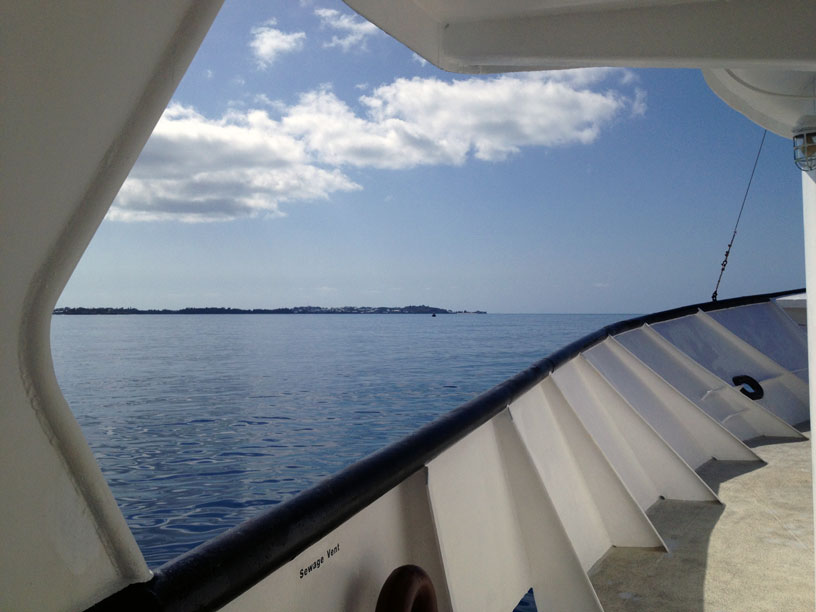 Returning to Bermuda—a lot calmer than when we left.
Returning to Bermuda—a lot calmer than when we left.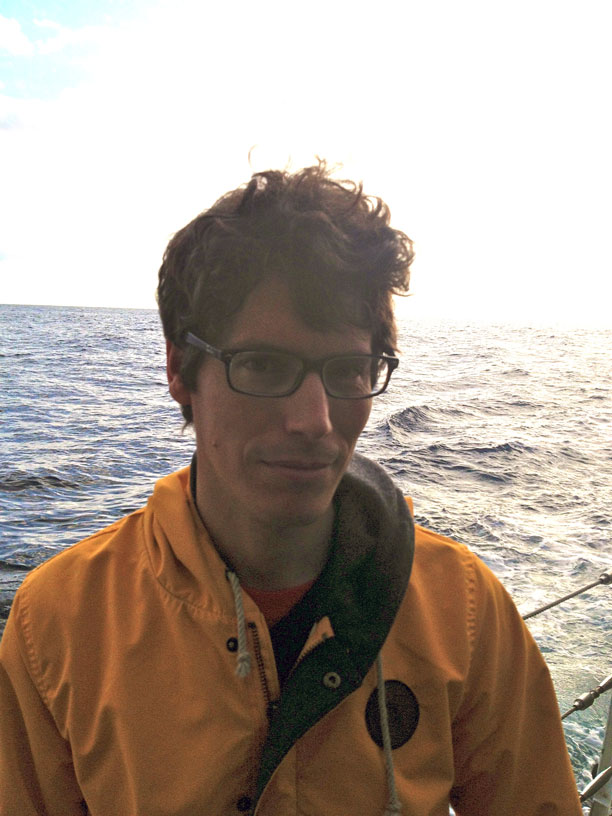 March 2013 (3/3): Tomorrow I am returning to my high school and I cannot tell a lie—it might be a little strange to walk into Middle Township High School and give a talk about being a scientist. In particular, I will be talking about how science can be really exciting, especially if you're an oceanographer / paleoceanographer. I made this image to help get the point across tomorrow:
March 2013 (3/3): Tomorrow I am returning to my high school and I cannot tell a lie—it might be a little strange to walk into Middle Township High School and give a talk about being a scientist. In particular, I will be talking about how science can be really exciting, especially if you're an oceanographer / paleoceanographer. I made this image to help get the point across tomorrow: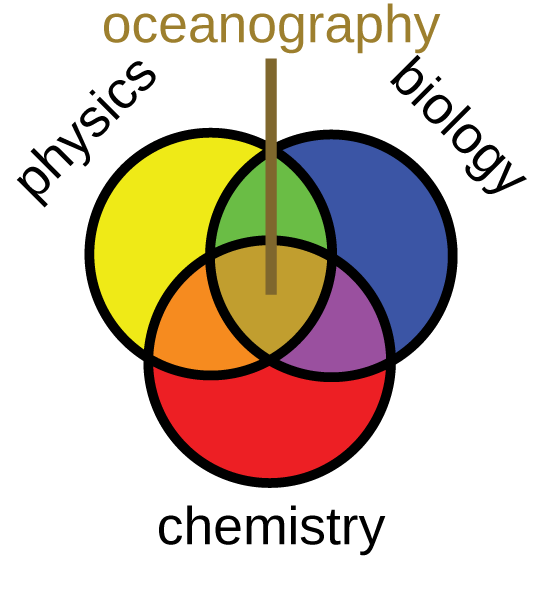 Get it? Oceanographers need to understand all the sciences. At least that's how I see it.March 2013 (2/3): Patrick Rafter goes to congress.Last week was the Marine Geosciences Leadership Symposium (MGLS or "MIGGLES") down in D.C. The place where nothing ever gets done! (that's a quote).
Get it? Oceanographers need to understand all the sciences. At least that's how I see it.March 2013 (2/3): Patrick Rafter goes to congress.Last week was the Marine Geosciences Leadership Symposium (MGLS or "MIGGLES") down in D.C. The place where nothing ever gets done! (that's a quote).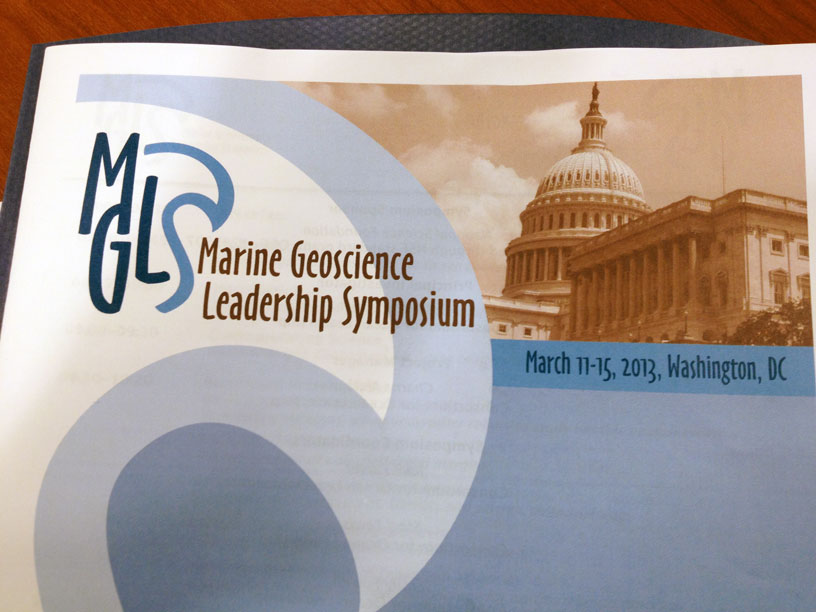 We met with Sheldon Whitehouse (D-RI), the staff of John Cornyn (R-TX) and Ted Cruz (R-TX), and with the senior person for the House of Representatives Committee for Science, Space, and Technology. It was, all around, an eye-opening day.
We met with Sheldon Whitehouse (D-RI), the staff of John Cornyn (R-TX) and Ted Cruz (R-TX), and with the senior person for the House of Representatives Committee for Science, Space, and Technology. It was, all around, an eye-opening day.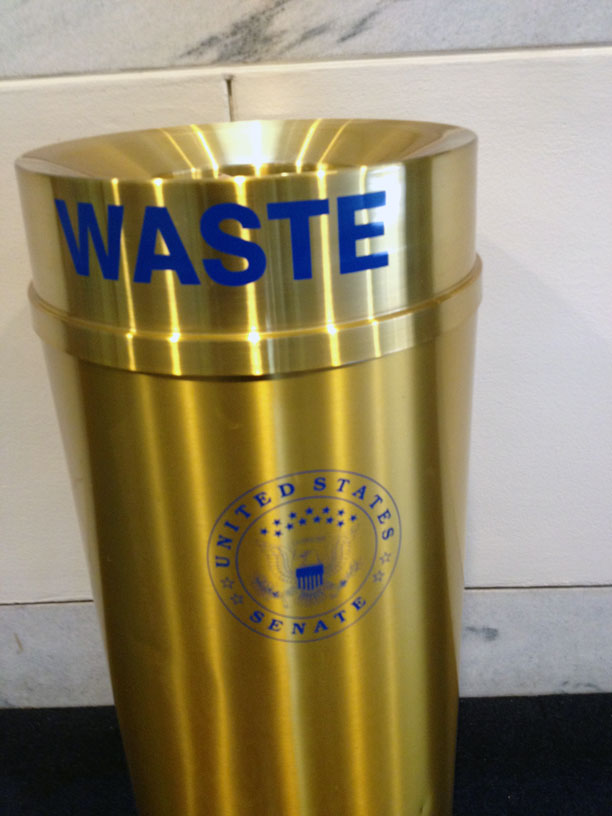 This waste can seems a little wasteful...
This waste can seems a little wasteful...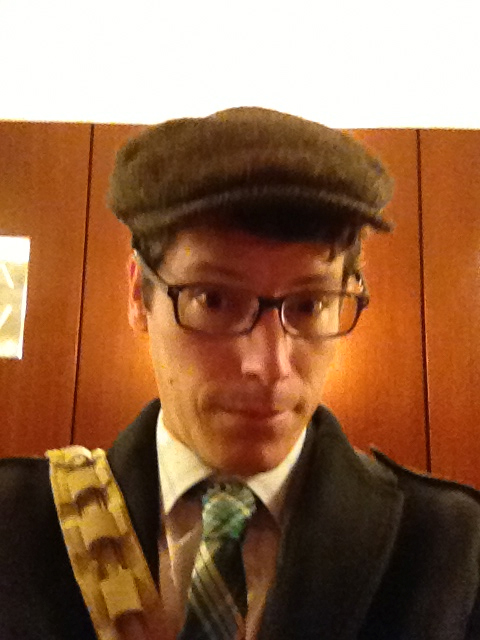 And then I went to see old man Lincoln:
And then I went to see old man Lincoln: March 2013 (1/3): I finally submitted this monster paper on nitrate isotopes and there are some really great figures that I can't wait to share. However, sharing unpublished data is (somewhat) frowned upon by the scientific journal community, so I will only share a figure that is of already published data!
March 2013 (1/3): I finally submitted this monster paper on nitrate isotopes and there are some really great figures that I can't wait to share. However, sharing unpublished data is (somewhat) frowned upon by the scientific journal community, so I will only share a figure that is of already published data!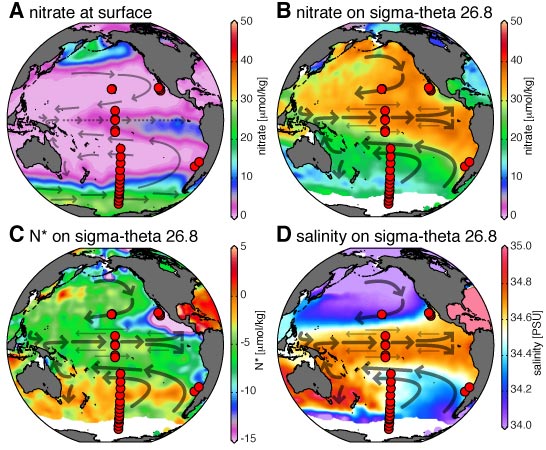 Super cool! (A) is nitrate concentration for the surface ocean and (B) is nitrate concentration at the depth where density is about 1026.8 kg/m3 (we just say "26.8" for this). This is about 500 m in the lower latitudes and is at the surface near the Southern Ocean (the white means there is no water of that density).(C) is the difference between nitrate and 16 times phosphate concentrations at this same density level and (D) shows salinity at that same density level. The interesting thing here is that salinity is low in the Southern Ocean surface and these waters get pushed deep and move towards the equator—but they don't go straight to the equator! They hook around the South Pacific gyre first and then get "saltier" as they mix with shallower waters in the Coral, Solomon, and Tasman Seas. Science is cool.February 2013 (2/2): Gave another job talk, with another advertisement:
Super cool! (A) is nitrate concentration for the surface ocean and (B) is nitrate concentration at the depth where density is about 1026.8 kg/m3 (we just say "26.8" for this). This is about 500 m in the lower latitudes and is at the surface near the Southern Ocean (the white means there is no water of that density).(C) is the difference between nitrate and 16 times phosphate concentrations at this same density level and (D) shows salinity at that same density level. The interesting thing here is that salinity is low in the Southern Ocean surface and these waters get pushed deep and move towards the equator—but they don't go straight to the equator! They hook around the South Pacific gyre first and then get "saltier" as they mix with shallower waters in the Coral, Solomon, and Tasman Seas. Science is cool.February 2013 (2/2): Gave another job talk, with another advertisement: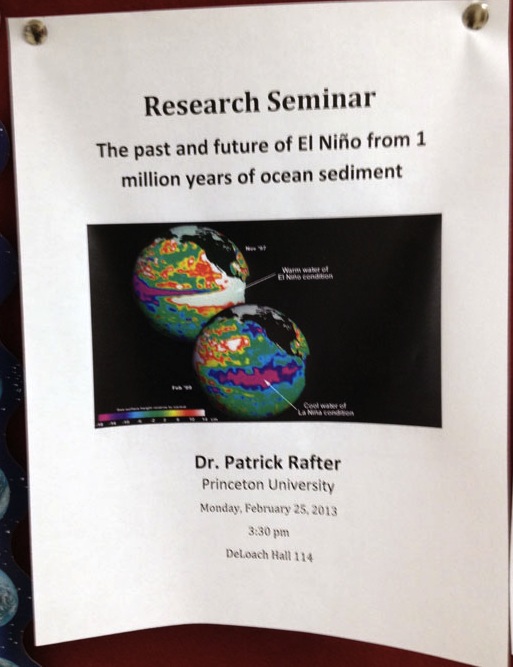 Sorry that these pictures are a little blurry—I was trying to take the picture without anyone noticing (it seems a little bit narcissistic, doesn't it?)Other advertisements for this talk:
Sorry that these pictures are a little blurry—I was trying to take the picture without anyone noticing (it seems a little bit narcissistic, doesn't it?)Other advertisements for this talk: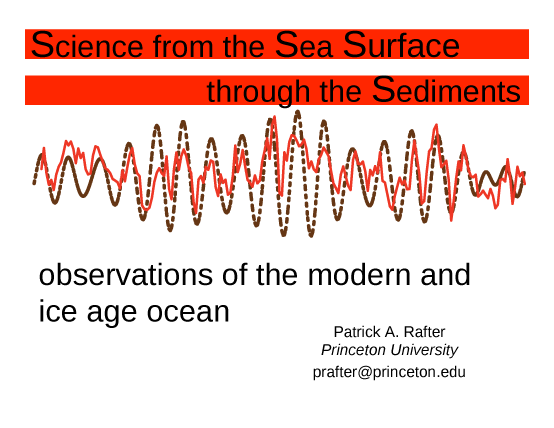
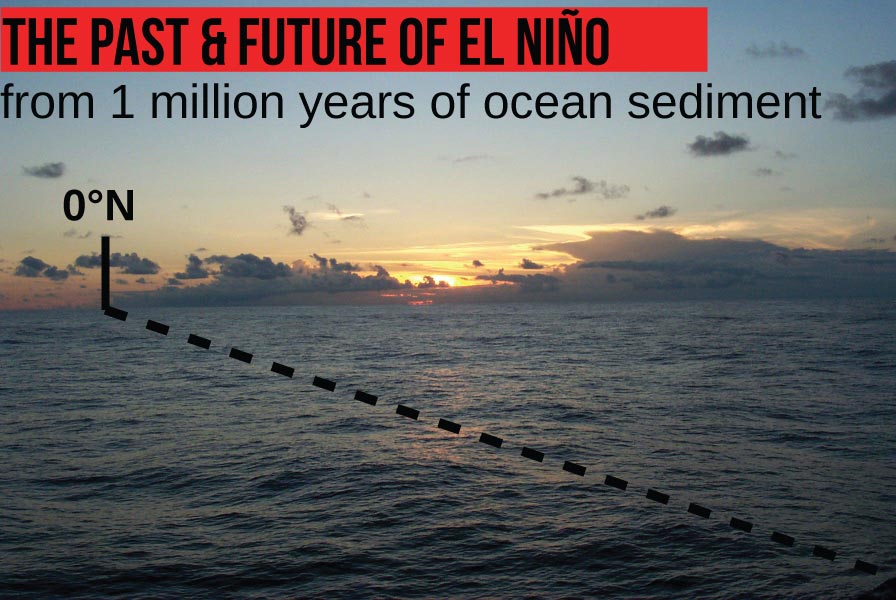
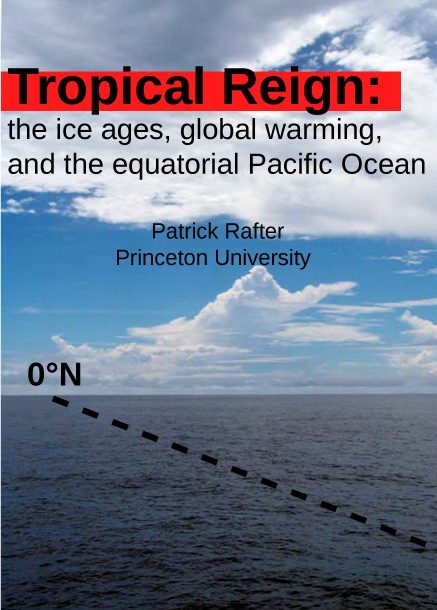 February 2013 (1/2): Gave a talk and here's how it was advertised:
February 2013 (1/2): Gave a talk and here's how it was advertised: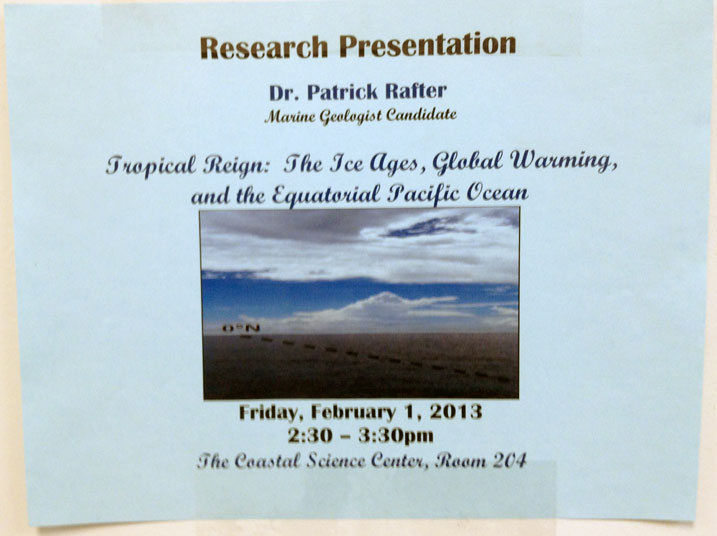 January 2013 (2/2): Had a great time last week at the DIMACS meeting (Discrete Mathematics and Theoretical Computer Science), wherepaleoceanography/paleoclimatology smashed into a mathematical wall... lots of interesting talks about how to correctly use statistics to analyze your data. Yes... it sounds boring, but it was great!
January 2013 (2/2): Had a great time last week at the DIMACS meeting (Discrete Mathematics and Theoretical Computer Science), wherepaleoceanography/paleoclimatology smashed into a mathematical wall... lots of interesting talks about how to correctly use statistics to analyze your data. Yes... it sounds boring, but it was great!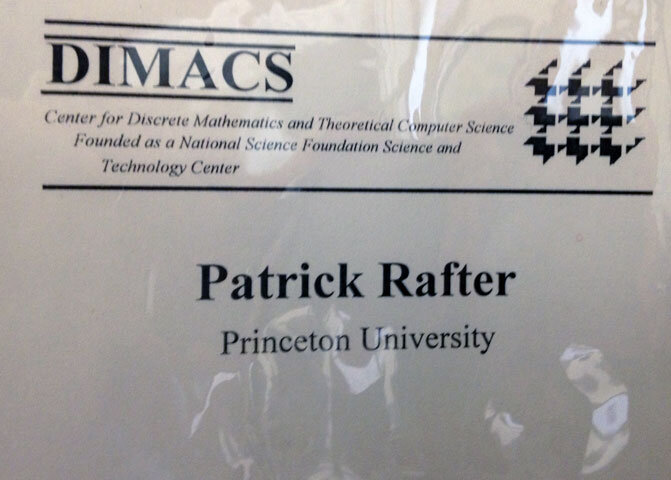 January 2013 (1/2): It's a new year and I forgot to mention some activities from 2012. First up, I was happy to be a part of the C-SOBOM site visit by NSF. This is a proposal put forward by scientists here at Princeton, at Scripps, and a variety of other institutions to produce a Southern Ocean Biogeochemisty "Center" here at PU (more on this if it gets funded). I presented my—as yet—unpublished data on Southern and Pacific Ocean nitrate isotopes that describes the role of organic matter remineralization throughout these regions. There is a neat video describing the importance of the Southern Ocean with Jorge Sarmiento as the lead here (those are icicles on the side of the ship):
January 2013 (1/2): It's a new year and I forgot to mention some activities from 2012. First up, I was happy to be a part of the C-SOBOM site visit by NSF. This is a proposal put forward by scientists here at Princeton, at Scripps, and a variety of other institutions to produce a Southern Ocean Biogeochemisty "Center" here at PU (more on this if it gets funded). I presented my—as yet—unpublished data on Southern and Pacific Ocean nitrate isotopes that describes the role of organic matter remineralization throughout these regions. There is a neat video describing the importance of the Southern Ocean with Jorge Sarmiento as the lead here (those are icicles on the side of the ship):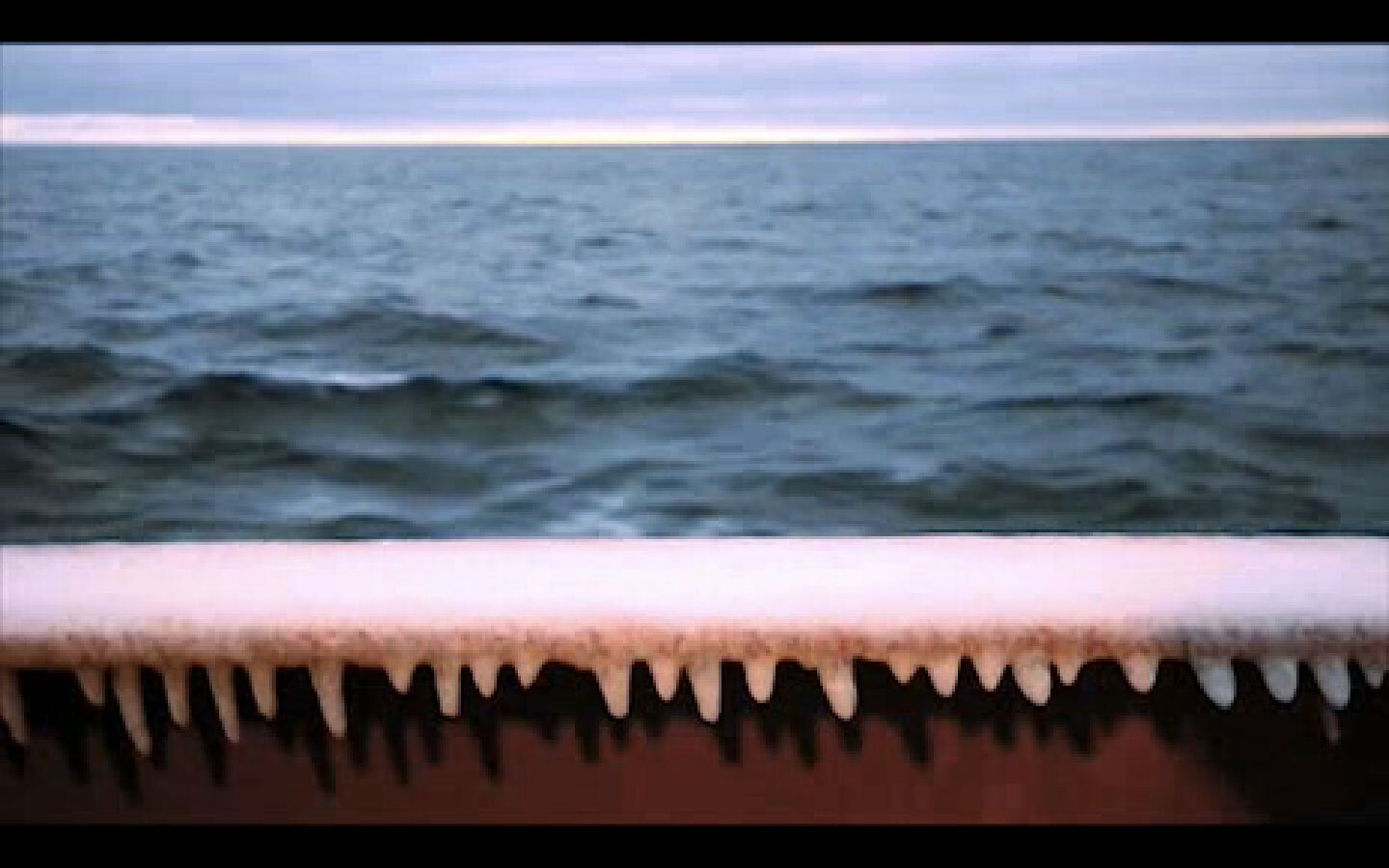 December 11 2012: I was sad to hear about the passing of Devendra Lal, a professor and pure-blooded scientist at Scripps Institution of Oceanography. We shared a few personality traits, such as being hard-headed, stubborn scientists who venerate curiousity and creative approaches to scientific questions. He made the last few years of graduate school quite nice when he told me that he was happy to see my progress as a graduate student and very excited to hear about my research. He was an inspiration.
December 11 2012: I was sad to hear about the passing of Devendra Lal, a professor and pure-blooded scientist at Scripps Institution of Oceanography. We shared a few personality traits, such as being hard-headed, stubborn scientists who venerate curiousity and creative approaches to scientific questions. He made the last few years of graduate school quite nice when he told me that he was happy to see my progress as a graduate student and very excited to hear about my research. He was an inspiration.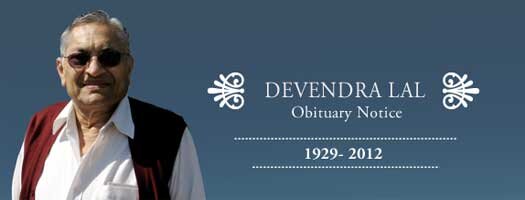 November/December 2012: A long week at the national AGU conference in San Francisco and a lot of good science, although I have to say that one of the best talks I saw was by my friend Sarah Fawcett!In other news, I was out to sea again last month, this time with Meytal Higgins as my first mate:
November/December 2012: A long week at the national AGU conference in San Francisco and a lot of good science, although I have to say that one of the best talks I saw was by my friend Sarah Fawcett!In other news, I was out to sea again last month, this time with Meytal Higgins as my first mate:
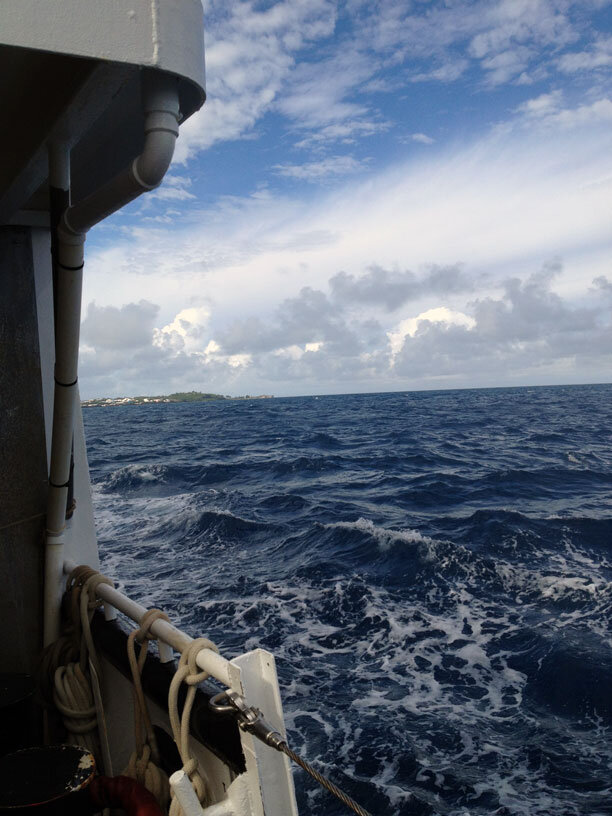
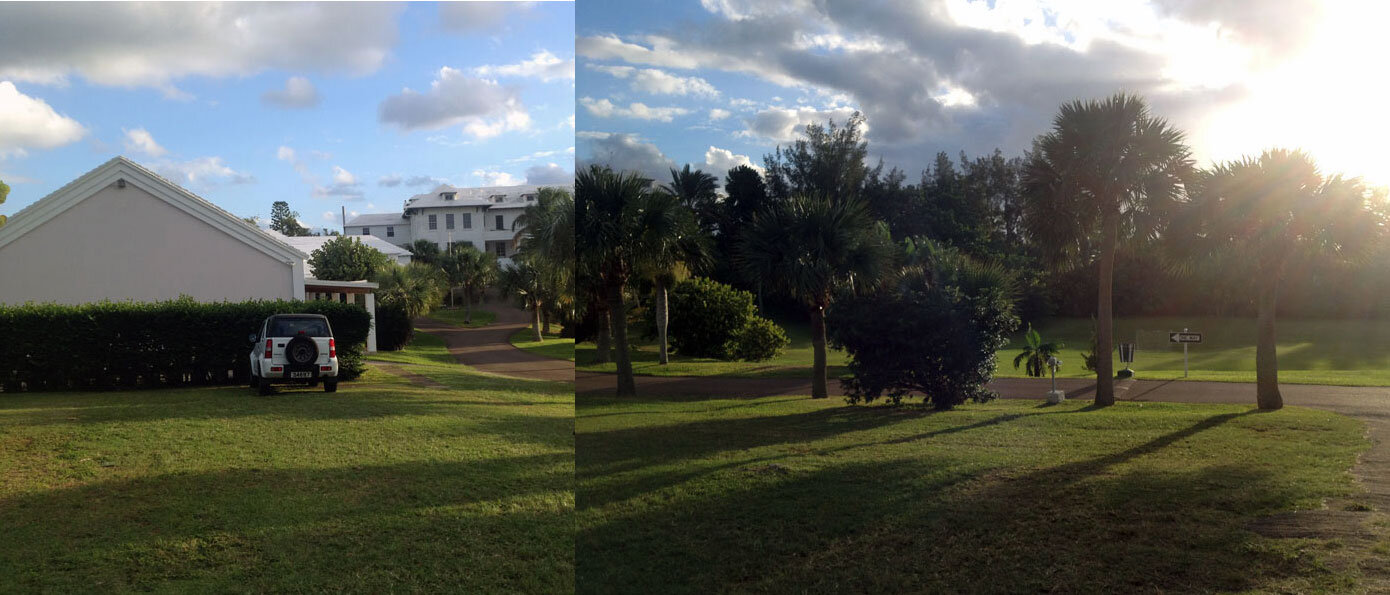 October 2012 (3/3): I was sad to hear that Ben Flower died recently. He was an unofficial mentor to me and several other young scientists at an IODP workshop last year in College Station. The earth sciences have definitely lost a great guy. See the whole article here.
October 2012 (3/3): I was sad to hear that Ben Flower died recently. He was an unofficial mentor to me and several other young scientists at an IODP workshop last year in College Station. The earth sciences have definitely lost a great guy. See the whole article here.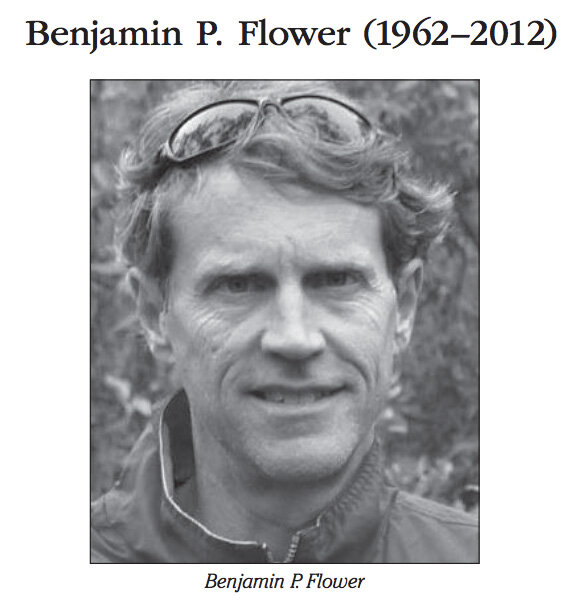 October 2012 (2/3): The publications are coming quickly now—the latest is a modeling paper in Biogeosciences Discussions that uses my nitrate isotope measurements to quantify the amount of denitrification in the ocean. It's pretty neat, so check it out here:
October 2012 (2/3): The publications are coming quickly now—the latest is a modeling paper in Biogeosciences Discussions that uses my nitrate isotope measurements to quantify the amount of denitrification in the ocean. It's pretty neat, so check it out here: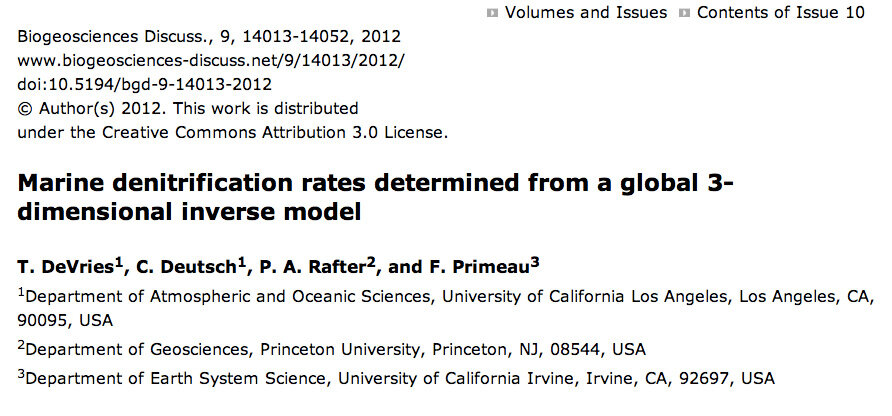 October 2012 (1/3): It's great to see that my Paleoceanography is not just one of the "Most Viewed", but it is THE top page view this week (97 since last Monday). If each of these page views are unique (i.e. each from a different person), then in the past two weeks there were over 200 people interested in this paper.
October 2012 (1/3): It's great to see that my Paleoceanography is not just one of the "Most Viewed", but it is THE top page view this week (97 since last Monday). If each of these page views are unique (i.e. each from a different person), then in the past two weeks there were over 200 people interested in this paper.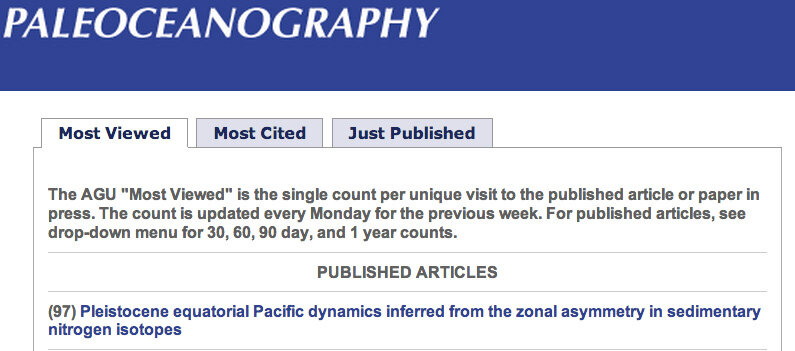 I also checked up on my GBC paper from January and it is still in the top 20 downloads of the past year (18 out of 20) with 168 page views, but falling fast:
I also checked up on my GBC paper from January and it is still in the top 20 downloads of the past year (18 out of 20) with 168 page views, but falling fast: September 2012 (1/2): I have a new paper out today: "Pleistocene equatorial Pacific dynamics inferred from the zonal asymmetry in sedimentary nitrogen isotopes" in Paleoceanography's "Currents" section. It is a great paper and I think you should download and read it. Link here.The data tells us that one aspect of the upper equatorial Pacific Ocean (consumption of the nutrient nitrate) is not affected by changes in greenhouse gas concentrations. "What's that mean for me," you might ask? Well, it's difficult to imagine a world where this stuff (nitrate consumption) doesn't reflect long-term changes in El Nino, which is important for global climate variability. Long story short, this data predicts that El Nino was affected by past changes in greenhouse gas concentrations and might not be affected by the current increase in these gases. However, the current and future concentrations are much higher than we "tested" for in the past—something future work will look into...First submitted early 2010. Reviewed to death at N. and then again at N. G. and then some more at Paleoceanography. A figure that is not included in the paper, but tells a lot about these measurements is here:
September 2012 (1/2): I have a new paper out today: "Pleistocene equatorial Pacific dynamics inferred from the zonal asymmetry in sedimentary nitrogen isotopes" in Paleoceanography's "Currents" section. It is a great paper and I think you should download and read it. Link here.The data tells us that one aspect of the upper equatorial Pacific Ocean (consumption of the nutrient nitrate) is not affected by changes in greenhouse gas concentrations. "What's that mean for me," you might ask? Well, it's difficult to imagine a world where this stuff (nitrate consumption) doesn't reflect long-term changes in El Nino, which is important for global climate variability. Long story short, this data predicts that El Nino was affected by past changes in greenhouse gas concentrations and might not be affected by the current increase in these gases. However, the current and future concentrations are much higher than we "tested" for in the past—something future work will look into...First submitted early 2010. Reviewed to death at N. and then again at N. G. and then some more at Paleoceanography. A figure that is not included in the paper, but tells a lot about these measurements is here: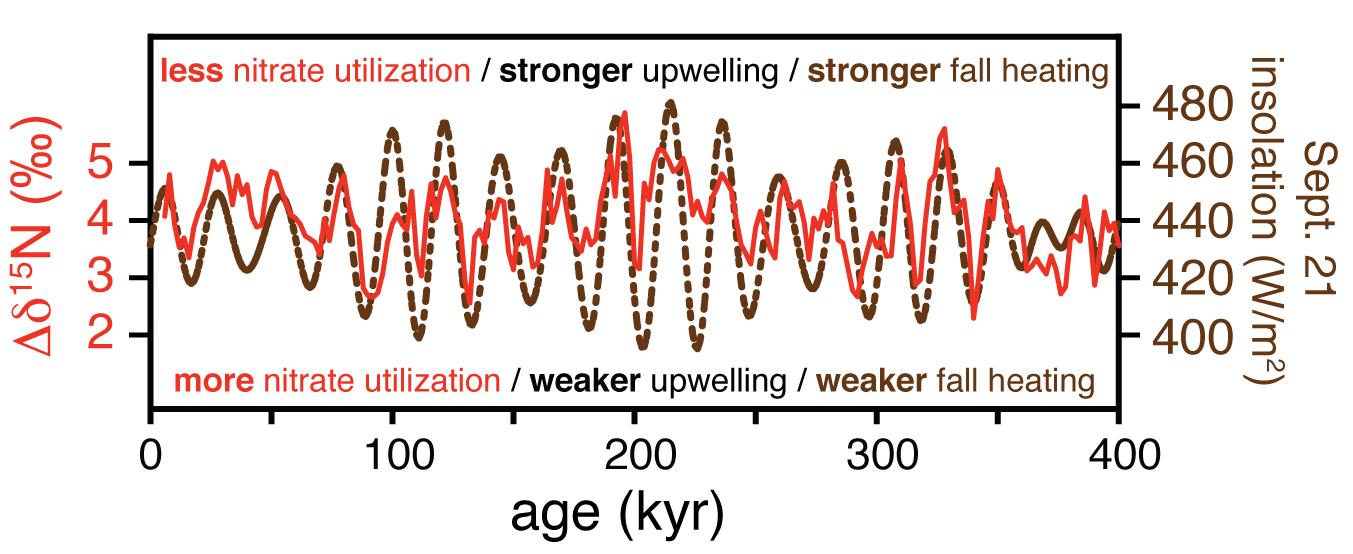 August 2012 (2/2): I am quite excited for George Philander's birthday, a.k.a. "Philanderfest", a.k.a. "The 2012 Philander Symposium" next month. It should be great and makes me think I'm at the right place at the right time:
August 2012 (2/2): I am quite excited for George Philander's birthday, a.k.a. "Philanderfest", a.k.a. "The 2012 Philander Symposium" next month. It should be great and makes me think I'm at the right place at the right time: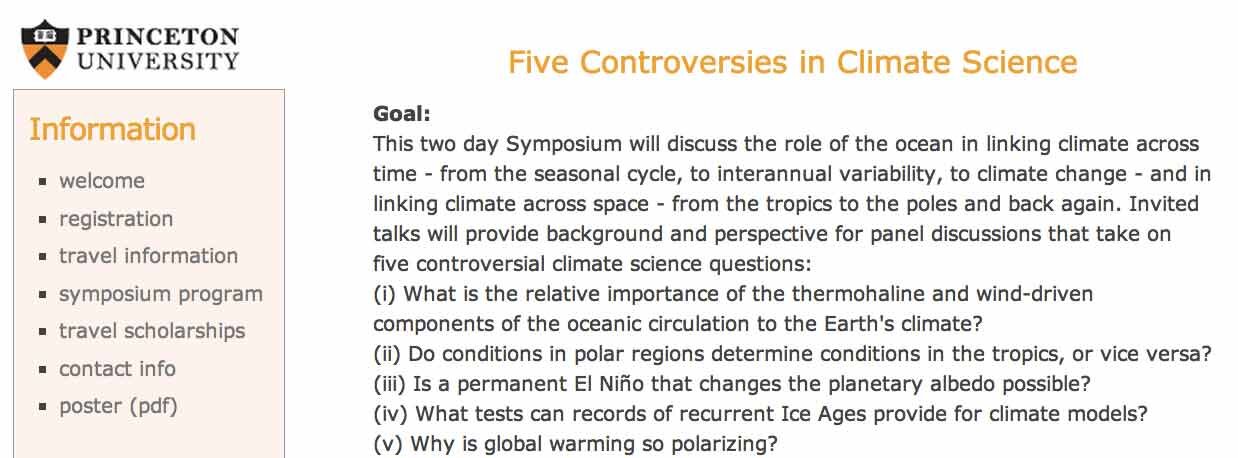 August 2012 (1/2): Do you like science? Of course you do, so you will probably findthis short history of discovery (and rediscovery) of the Equatorial Under Current to be very interesting (link here). It's by the well-known Mike McPhaden who most people know as the President of the American Geophysical Union, but I know him as the guy I sailed with from San Diego to the Galapagos (what a great trip). Speaking of which, here's a photo I took while we were passing under the Intertropical Convergence Zone (ITCZ: also known to non-scientists as the place on the planet where it rains a lot).
August 2012 (1/2): Do you like science? Of course you do, so you will probably findthis short history of discovery (and rediscovery) of the Equatorial Under Current to be very interesting (link here). It's by the well-known Mike McPhaden who most people know as the President of the American Geophysical Union, but I know him as the guy I sailed with from San Diego to the Galapagos (what a great trip). Speaking of which, here's a photo I took while we were passing under the Intertropical Convergence Zone (ITCZ: also known to non-scientists as the place on the planet where it rains a lot). July 2012 (1/2): The North Atlantic is nice this time of year—yes, I went back to Bermuda and BATS as part of a project to understand the cycling of nitrogen in the subtropical gyre surface waters. A big part of this project is collecting foraminifera, which will be analyzed for their N isotopic composition (both their biomass and their "test", a.k.a. their shell). This will hugely help the interpretation of sedimentary foraminifera d15N (this time just their test, since the biomass is long-gone). Here are some images from the trip:
July 2012 (1/2): The North Atlantic is nice this time of year—yes, I went back to Bermuda and BATS as part of a project to understand the cycling of nitrogen in the subtropical gyre surface waters. A big part of this project is collecting foraminifera, which will be analyzed for their N isotopic composition (both their biomass and their "test", a.k.a. their shell). This will hugely help the interpretation of sedimentary foraminifera d15N (this time just their test, since the biomass is long-gone). Here are some images from the trip: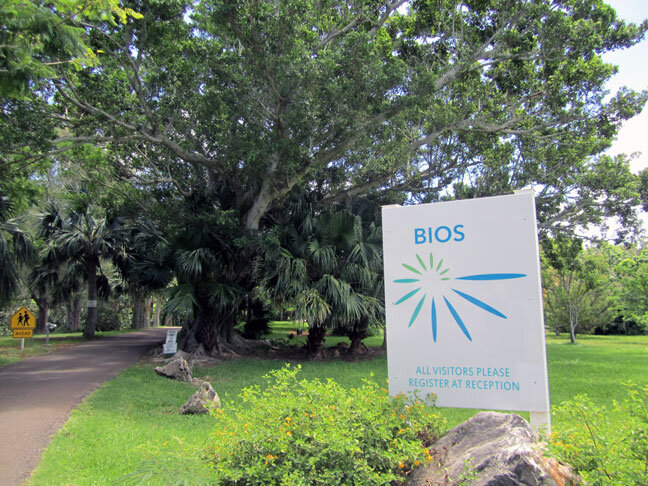 BIOS got a new logo. There was a lot of conversation about the new design.
BIOS got a new logo. There was a lot of conversation about the new design. Your author, up on the bow, thinking about the upcoming cruise
Your author, up on the bow, thinking about the upcoming cruise My science team, Tyler Tamasi and Figen Mekik, putting in that extra bit of effort to improve our gravity filtration
My science team, Tyler Tamasi and Figen Mekik, putting in that extra bit of effort to improve our gravity filtration Flat seas and nice weather. Can't ask for much better (yes, I will try to make more rhymes a part of this webpage).June 2012 (2/2): And so we are off for a week of thrilling science (geochemistry, to be specific) in Montreal. My boss Danny Sigman will be receiving the EAG Science Innovation Award in Biogeochemistry.
Flat seas and nice weather. Can't ask for much better (yes, I will try to make more rhymes a part of this webpage).June 2012 (2/2): And so we are off for a week of thrilling science (geochemistry, to be specific) in Montreal. My boss Danny Sigman will be receiving the EAG Science Innovation Award in Biogeochemistry.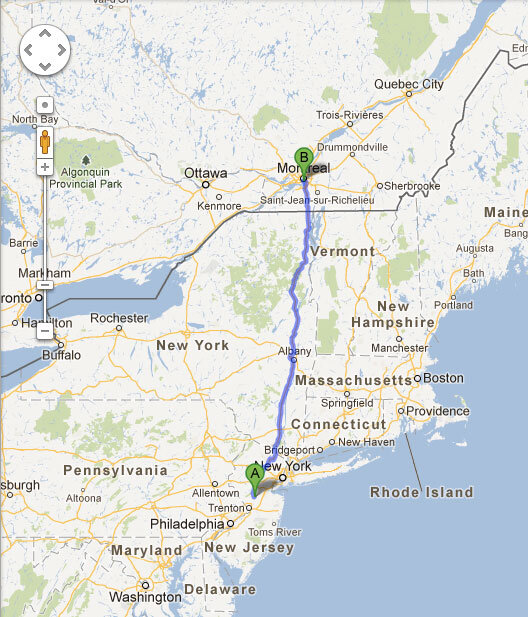 June 2012 (1/2):
June 2012 (1/2):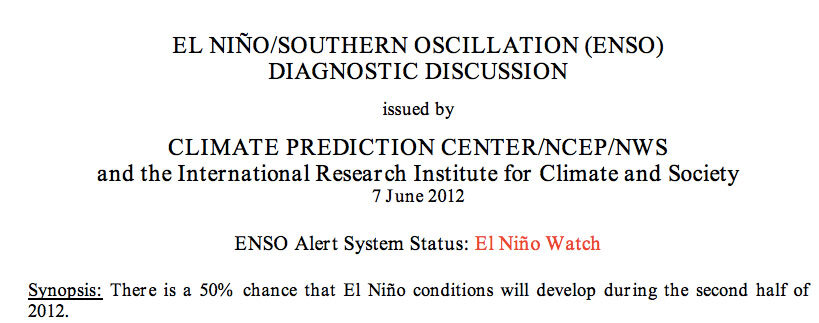 I am getting ready for ANOTHER cruise off Bermuda (in July), which is part of a multi-year study of zooplankton and their role in surface ocean cycling of nitrogen.More on that when I get back from the cruise, but right now I thought it would be interesting to speculate about the Pacific—in particular, future ENSO conditions.We have just experienced a fairly large La Nina, but things are changing quickly in the tropical Pacific, such that we are already seeing an increase in the MEI to 0.7 (a way to measure conditions favoring El Nino or La Nina). As it is, there is a 50% chance we will go into another El Nino.This is a complicated topic, but this could be bad news for places just now recovering from the devastating wild fires associated with the last El Nino (like Australia), because El Nino events are associated with a shift in precipitation from the western side of the tropical Pacific to the central or eastern side (drying out northern Australia, Papua New Guinea, and possibly other regions as well). If El Nino conditions are established, the next question to ask is what kind of El Nino is it? The last El Nino was considered a somewhat weak, central equatorial Pacific version, versus the very strong eastern El Ninos of 1982-83 and 1997-98.Either way, it would be interesting to acquire seawater samples from areas influenced by ENSO and, as it happens, I have been! With the help of the CalCOFI program, I have been collecting seawater samples from the California Margin since spring 2010 and one of my goals is to see if changes in ENSO affect the nutrients delivered in these waters. The connection to the tropics occurs through a deep current (the California Undercurrent) that brings warm, salty, nutrient-rich waters from the tropics.As a student at Scripps, I would look out from the San Diego coastline and think about this source of "spicy" tropical water—wondering if ENSO can affect the delivery or change the characteristics of these waters (and the nutrients within these waters). One of the reasons we care about these things is that IF there is a change in these nutrients, we would expect there to be changes in the growth of phytoplankton and thereby, the growth of fish that eat the phytoplankton. I don't eat fish, but plenty of people do and either way, it is an important part of the west coast economy. I also care about what controls the delivery of nutrients because many of the paleoceanographic tools we use to understand past oceanic conditions rely upon the growth of phytoplankton.April 2012: Just returned from a succesful research cruise in the North Atlantic. Thank you to all the BIOS and BATS personnel who provided essential support before, during, and after the cruise!Getting ready to deploy the net in the early hours of a cool North Atlantic day:
I am getting ready for ANOTHER cruise off Bermuda (in July), which is part of a multi-year study of zooplankton and their role in surface ocean cycling of nitrogen.More on that when I get back from the cruise, but right now I thought it would be interesting to speculate about the Pacific—in particular, future ENSO conditions.We have just experienced a fairly large La Nina, but things are changing quickly in the tropical Pacific, such that we are already seeing an increase in the MEI to 0.7 (a way to measure conditions favoring El Nino or La Nina). As it is, there is a 50% chance we will go into another El Nino.This is a complicated topic, but this could be bad news for places just now recovering from the devastating wild fires associated with the last El Nino (like Australia), because El Nino events are associated with a shift in precipitation from the western side of the tropical Pacific to the central or eastern side (drying out northern Australia, Papua New Guinea, and possibly other regions as well). If El Nino conditions are established, the next question to ask is what kind of El Nino is it? The last El Nino was considered a somewhat weak, central equatorial Pacific version, versus the very strong eastern El Ninos of 1982-83 and 1997-98.Either way, it would be interesting to acquire seawater samples from areas influenced by ENSO and, as it happens, I have been! With the help of the CalCOFI program, I have been collecting seawater samples from the California Margin since spring 2010 and one of my goals is to see if changes in ENSO affect the nutrients delivered in these waters. The connection to the tropics occurs through a deep current (the California Undercurrent) that brings warm, salty, nutrient-rich waters from the tropics.As a student at Scripps, I would look out from the San Diego coastline and think about this source of "spicy" tropical water—wondering if ENSO can affect the delivery or change the characteristics of these waters (and the nutrients within these waters). One of the reasons we care about these things is that IF there is a change in these nutrients, we would expect there to be changes in the growth of phytoplankton and thereby, the growth of fish that eat the phytoplankton. I don't eat fish, but plenty of people do and either way, it is an important part of the west coast economy. I also care about what controls the delivery of nutrients because many of the paleoceanographic tools we use to understand past oceanic conditions rely upon the growth of phytoplankton.April 2012: Just returned from a succesful research cruise in the North Atlantic. Thank you to all the BIOS and BATS personnel who provided essential support before, during, and after the cruise!Getting ready to deploy the net in the early hours of a cool North Atlantic day: Leaving Bermuda for BATS:
Leaving Bermuda for BATS: And thank you to my scientific team, Michelle Drake and Tom Serwatka:
And thank you to my scientific team, Michelle Drake and Tom Serwatka: March 2012: If you are interested in sedimentary nitrogen isotopes (and I know you are), please download and read the report I wrote for a workshop last summer (NItrogen Cycle in the Ocean, Past and Present—(NICOPP):
March 2012: If you are interested in sedimentary nitrogen isotopes (and I know you are), please download and read the report I wrote for a workshop last summer (NItrogen Cycle in the Ocean, Past and Present—(NICOPP): You can download the entire PAGES newsletter HERE or just go to their website HERE.February 2012: Ocean Sciences is in Salt Lake City, Utah this year. I would have liked to have it held somewhere near the ocean (!), but there are great sessions this week and I'm excited to see all the new research. There is a session on "Linking the OMZ with the open ocean" and it couldn't have been more tailored to my own work. This session is the last day of the week and here's a sneak peak of my talk:
You can download the entire PAGES newsletter HERE or just go to their website HERE.February 2012: Ocean Sciences is in Salt Lake City, Utah this year. I would have liked to have it held somewhere near the ocean (!), but there are great sessions this week and I'm excited to see all the new research. There is a session on "Linking the OMZ with the open ocean" and it couldn't have been more tailored to my own work. This session is the last day of the week and here's a sneak peak of my talk: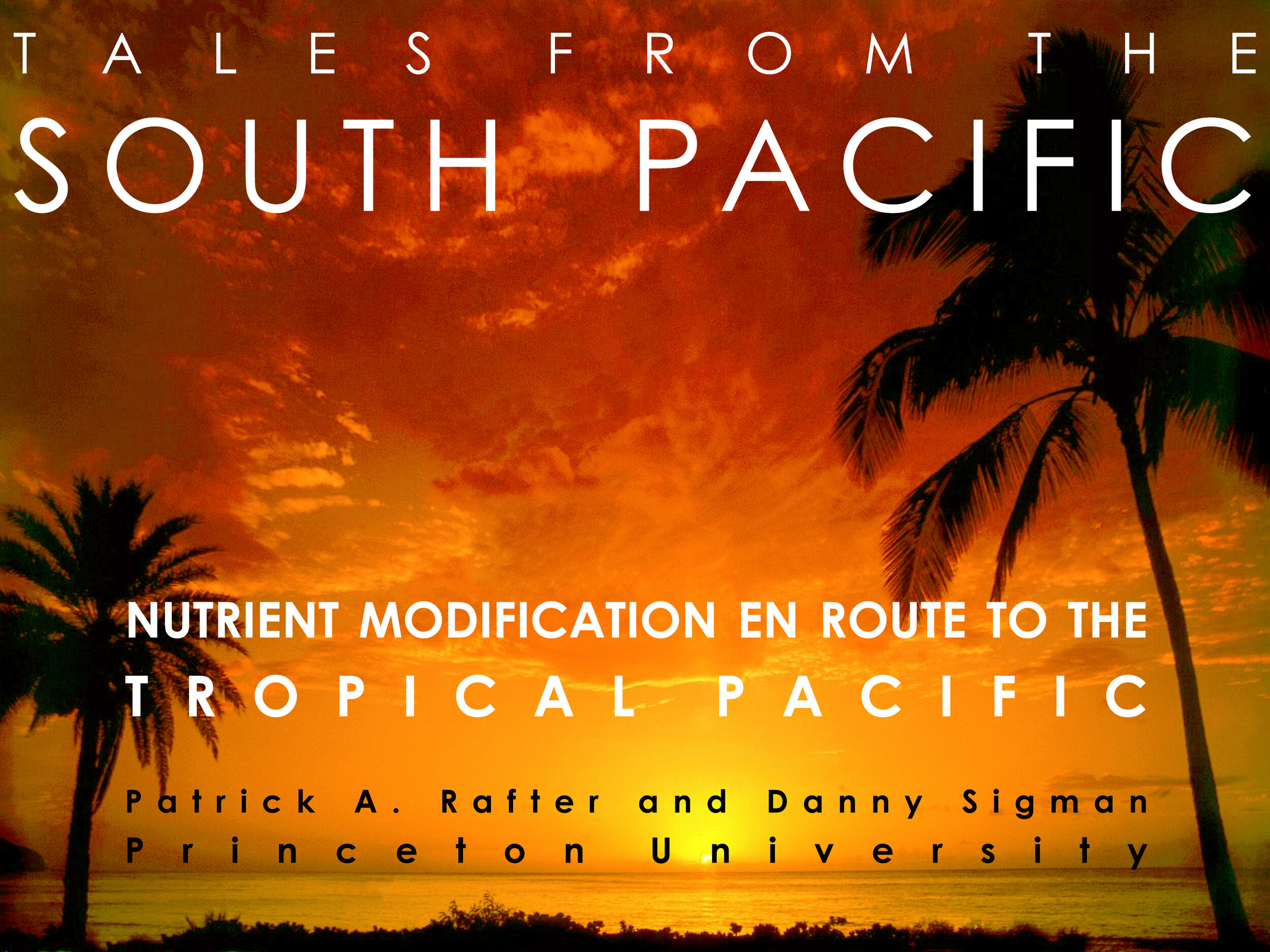 January 2012: My paper on tropical Pacific nitrate d15N (and how it got that way) is out and I was happy to see it is the most popular manuscript at GBC this month. Submitted for review October 2010, published in 2012... lesson learned. Publishing can take years (even when there are no problems with the paper). Peer review is slow.LINK HERE
January 2012: My paper on tropical Pacific nitrate d15N (and how it got that way) is out and I was happy to see it is the most popular manuscript at GBC this month. Submitted for review October 2010, published in 2012... lesson learned. Publishing can take years (even when there are no problems with the paper). Peer review is slow.LINK HERE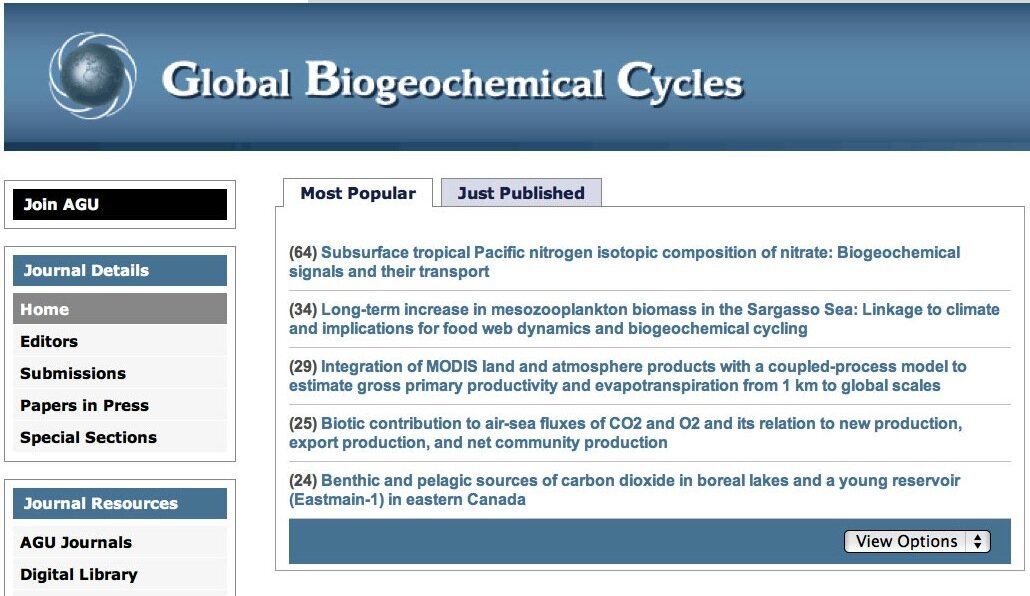 December 2011: When I was in graduate school (at Scripps Insitution of Oceanography), a local high school student named Ulisses Barraza helped me preprare hundreds of sediment samples for N isotopic analysis during his summer vacation. He was a huge help and he later went on to UCLA where he is majoring in chemical engineering.The latest news from him is that he recently visited the White House on behalf of San Diego's Ocean Discovery Institute (link here). Great going, Ulisses!August 2011: Had an amazing time at the Gordon Chemical Oceanography conference... I had always heard about these and I was finally able to see what it's all about.It's impressive. Great talks all day with a healthy break for playtime / socializing after lunch, then posters for a few hours at night. Here's a photo of some nitrogen enthusiasts:
December 2011: When I was in graduate school (at Scripps Insitution of Oceanography), a local high school student named Ulisses Barraza helped me preprare hundreds of sediment samples for N isotopic analysis during his summer vacation. He was a huge help and he later went on to UCLA where he is majoring in chemical engineering.The latest news from him is that he recently visited the White House on behalf of San Diego's Ocean Discovery Institute (link here). Great going, Ulisses!August 2011: Had an amazing time at the Gordon Chemical Oceanography conference... I had always heard about these and I was finally able to see what it's all about.It's impressive. Great talks all day with a healthy break for playtime / socializing after lunch, then posters for a few hours at night. Here's a photo of some nitrogen enthusiasts:
 July 2011: Drove to Nova Scotia for an excellent meeting discussing (what else?) nitrogen isotopes! It was the NiCOPP meeting (Nitrogen Cycle in the Ocean, Past and Present). I had a great time staying at Dalhousie and venturing out to the coastline (there were good waves my last day there). It's incredibly pretty there. Look for my report on the meeting in an upcoming PAGESnewsletter.
July 2011: Drove to Nova Scotia for an excellent meeting discussing (what else?) nitrogen isotopes! It was the NiCOPP meeting (Nitrogen Cycle in the Ocean, Past and Present). I had a great time staying at Dalhousie and venturing out to the coastline (there were good waves my last day there). It's incredibly pretty there. Look for my report on the meeting in an upcoming PAGESnewsletter.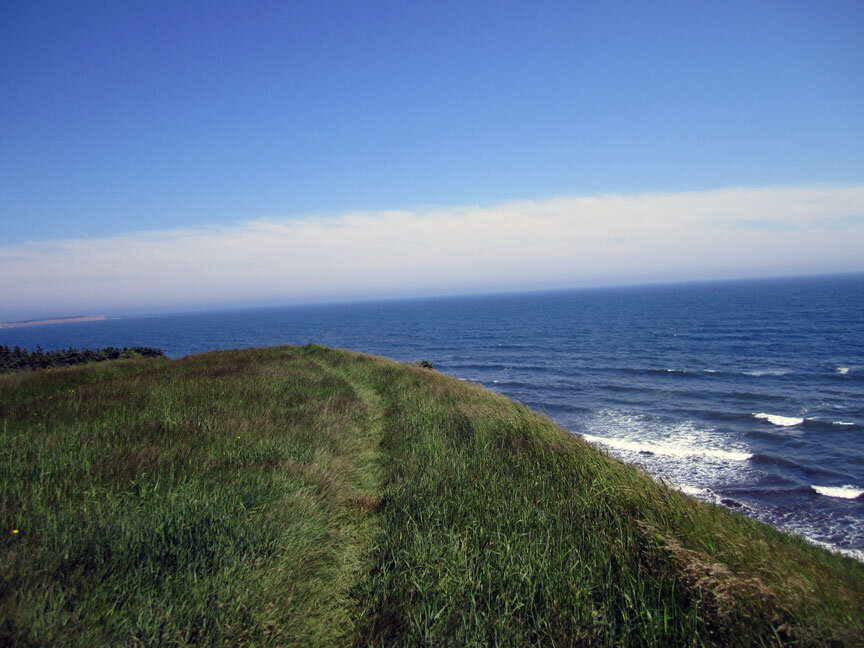 March 2011: I was invited down to College Station, Texas for a meeting by the "International Ocean Discovery Program" (yes, that is their new name). It was an Early Career Workshop concerning ocean drilling and such. I, conveniently, needed to sample some cores and got to see the huge refrigerators holding all the sediment cores.Here I am:
March 2011: I was invited down to College Station, Texas for a meeting by the "International Ocean Discovery Program" (yes, that is their new name). It was an Early Career Workshop concerning ocean drilling and such. I, conveniently, needed to sample some cores and got to see the huge refrigerators holding all the sediment cores.Here I am: February 2011: I gave a talk here at Princeton with (what I thought) was a rather clever title:
February 2011: I gave a talk here at Princeton with (what I thought) was a rather clever title: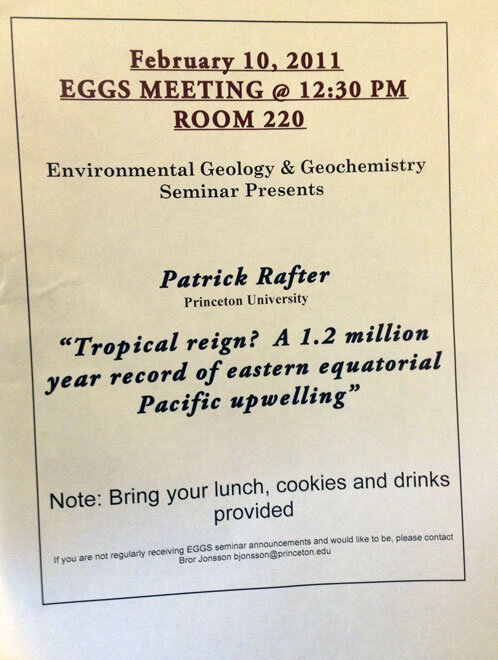 September 2010: Back to San Diego—I am attending the International Conference on Paleoceanography at UCSD. I designed the logo:
September 2010: Back to San Diego—I am attending the International Conference on Paleoceanography at UCSD. I designed the logo: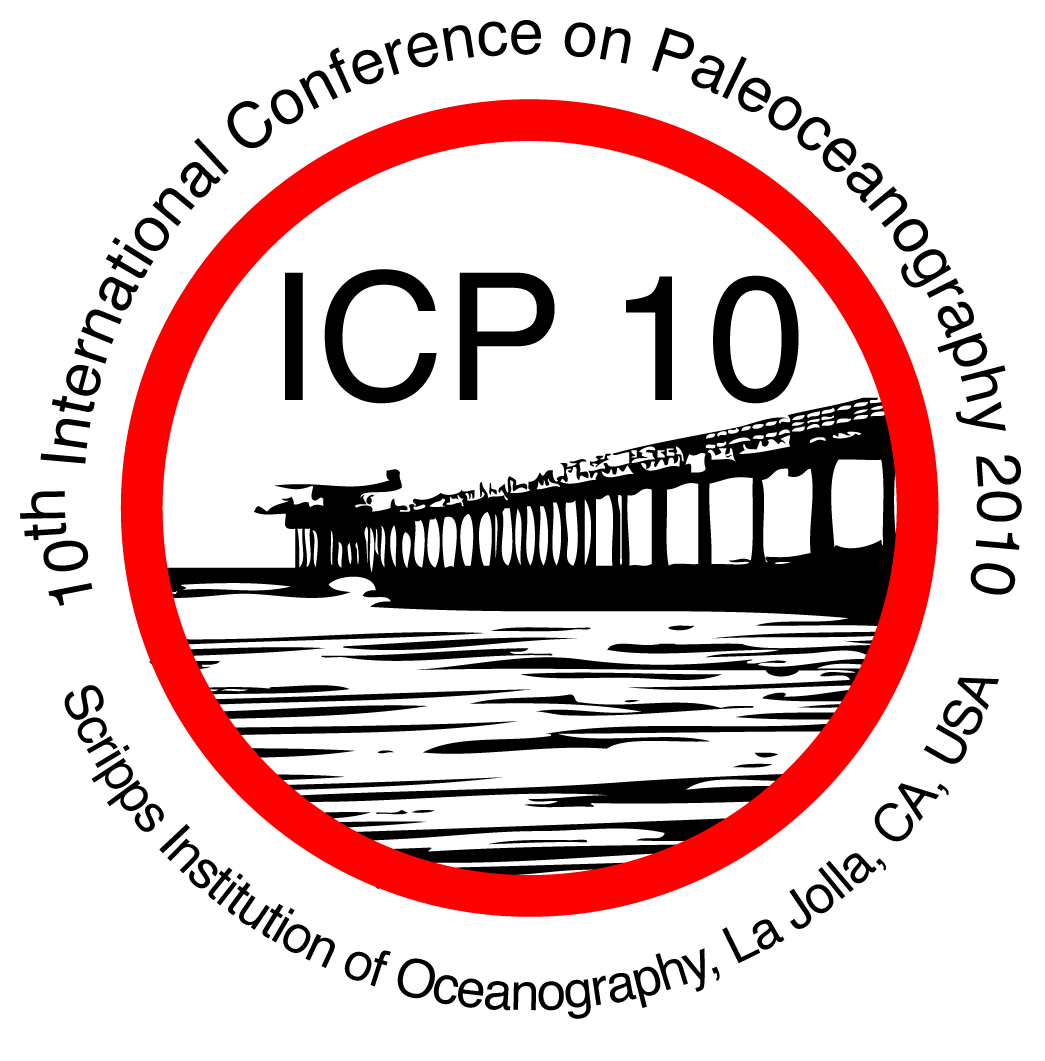 That's a stylized version of Scripps pier. I had some good times alongside that pier.April 2010: I'm busy making lots of nitrate isotope measurements in the lab and have been wondering what nitrate d15N and d18O looks like for the coastal ocean. My first insight was that there is no nitrate is south Jersey surface water (just outside the wave zone in Avalon, NJ where I grew up). My "local" surf spot in Sea Girt has around 6.3 uM nitrate in the surface coastal layer. I wonder what the isotopes will look like?
That's a stylized version of Scripps pier. I had some good times alongside that pier.April 2010: I'm busy making lots of nitrate isotope measurements in the lab and have been wondering what nitrate d15N and d18O looks like for the coastal ocean. My first insight was that there is no nitrate is south Jersey surface water (just outside the wave zone in Avalon, NJ where I grew up). My "local" surf spot in Sea Girt has around 6.3 uM nitrate in the surface coastal layer. I wonder what the isotopes will look like?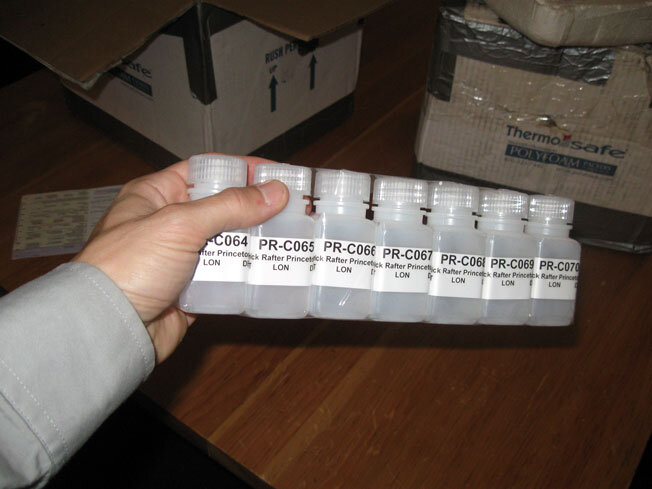 Sample bottles—ready for action.February 2010: If it's February and it's an even-numbered year, it must be Ocean Sciences. This time around I gave a talk on my equatorial Pacific nitrate d15N measurements (and what they mean for nutrient pathways around the south Pacific). Link to my abstract here. (Nitrate is a necessary nutrient for plants growing in the ocean.)
Sample bottles—ready for action.February 2010: If it's February and it's an even-numbered year, it must be Ocean Sciences. This time around I gave a talk on my equatorial Pacific nitrate d15N measurements (and what they mean for nutrient pathways around the south Pacific). Link to my abstract here. (Nitrate is a necessary nutrient for plants growing in the ocean.)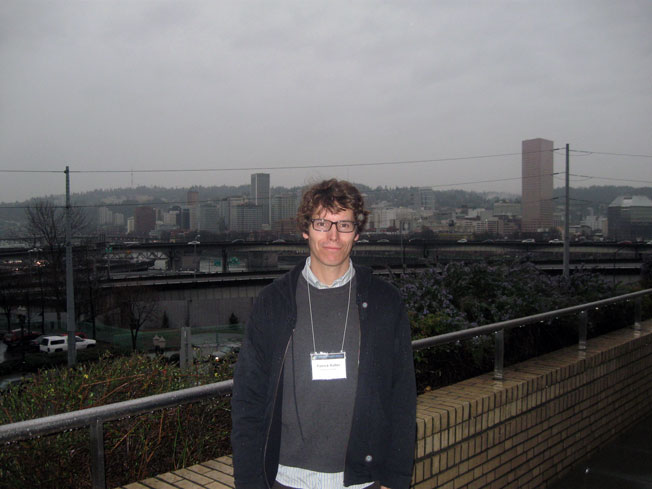 News flash: it's cloudy and rainy in Portland, OR.September/October 2009: My return to New Jersey! I am a NJ native, but it's been a long time. I'm excited to be working in the Sigman lab.
News flash: it's cloudy and rainy in Portland, OR.September/October 2009: My return to New Jersey! I am a NJ native, but it's been a long time. I'm excited to be working in the Sigman lab.
